Special Report
50 Worst American Cities to Live In
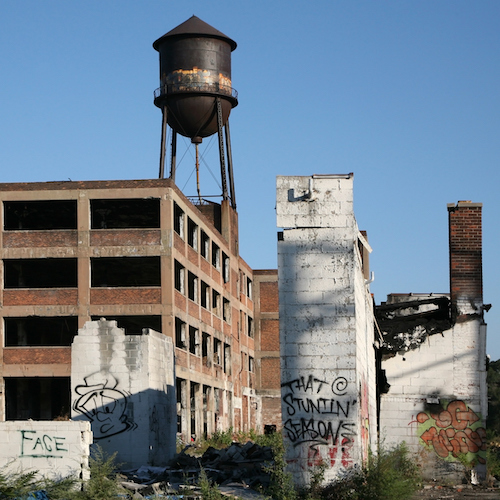
Published:
Last Updated:

Quality of life in an American city often depends on the neighborhood one lives in, as abject poverty and crime can be found just blocks away from prosperity. Still, as much as a city can be judged on the whole, some cities face widespread problems that detract from their residents’ overall quality of life.
Americans take into consideration a number of factors when deciding where to live, including the quality of schools, the strength of the local economy and job market, the area’s safety and culture, as well as its climate. Cities that perform well by these measures are more likely to attract new residents, and those that do not tend to drive residents away.
To determine America’s worst cities to live in, 24/7 Wall St. reviewed data on the 551 U.S. cities with a population of 65,000 or more as measured by the U.S. Census Bureau. Based on a range of variables, including crime rates, employment growth, access to restaurants and attractions, educational attainment, and housing affordability, 24/7 Wall St. identified America’s 50 worst cities to live.
Click here to see the 50 worst cities to live in.
Click here to see our detailed findings.
Click here to see our methodology.
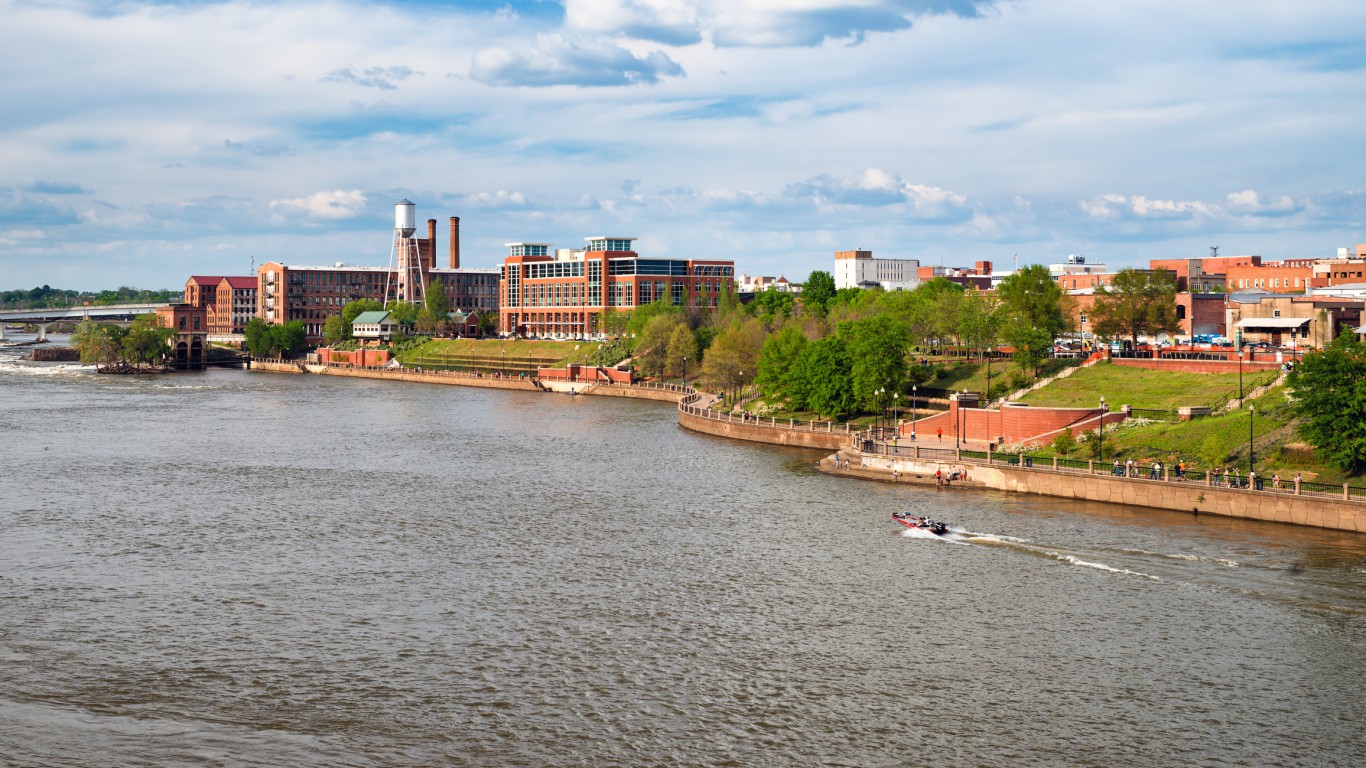
50. Columbus, Georgia
> Population: 200,579
> Median home value: $137,000
> Poverty rate: 21.8%
> Pct. with at least a bachelor’s degree: 24.5%
While it is not the only factor, wealth can have a significant impact on a population’s quality of life. The typical Columbus household earns just $41,859 a year, much lower than the median income nationwide of $55,775. In addition, goods and services are about 4% more expensive on average in Columbus than across the country as a whole. Further, it appears the regional economy is getting worse. While national employment increased by 4% between 2013 and 2015, employment in Columbus declined by 2.9%, the largest decline of the 551 cities reviewed.
High crime is an obvious hindrance to quality of life, and violent crime is relatively common in Columbus. There were 556 violent crimes reported for every 100,000 city residents in 2015 compared to a national violent crime rate of 373 incidents per 100,000 people. The city’s property crime rate of 5,543 incidents per 100,000 residents in 2015 was more than double the national property crime rate of 2,487 per 100,000 people.
[in-text-ad]
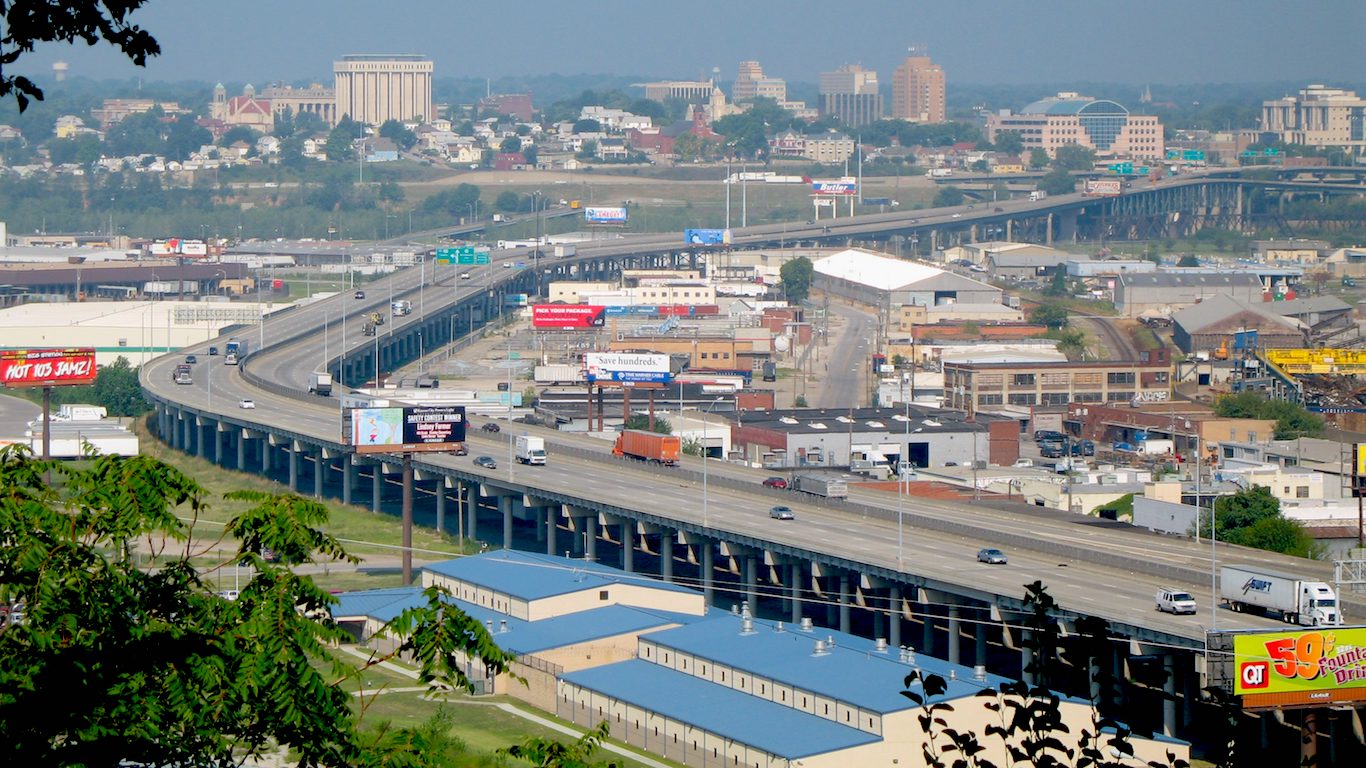
49. Kansas City, Kansas
> Population: 151,261
> Median home value: $87,600
> Poverty rate: 22.2%
> Pct. with at least a bachelor’s degree: 16.3%
While low property values can help make homeownership a reality for financially insecure individuals, cheap housing is more often indicative of a weak economy and poor living conditions — and this appears to be the case in Kansas City. The typical home in the city is worth just $87,600, far less than the $194,500 national median home value.
Relative to the size of its population, Kansas City has very few amenities and attractions that might enrich the lives of residents. There are fewer bars, libraries, recreational centers, museums, and hotels per capita in Kansas City than there are in the U.S. as a whole. There are just 120 restaurants per 100,000 Kansas City residents, among the fewest food establishments per capita of any U.S. city.
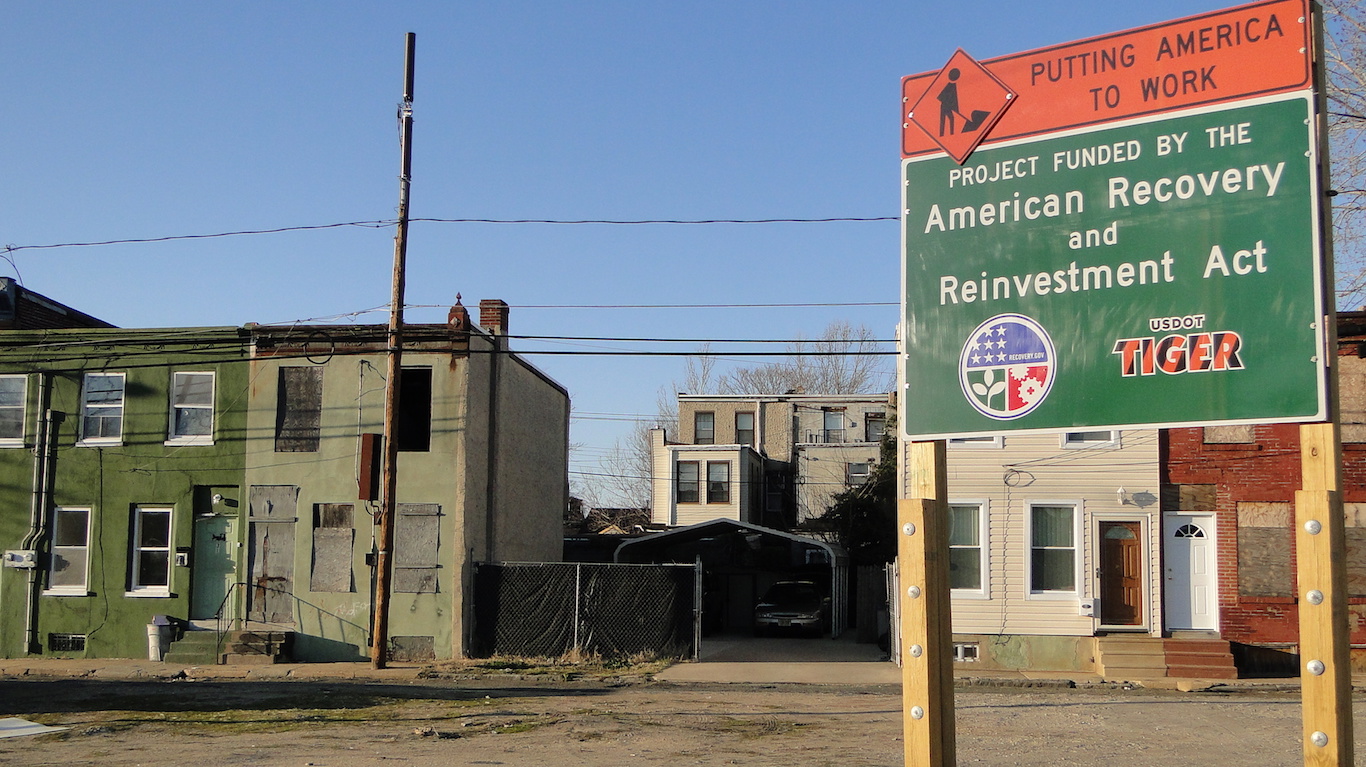
48. Camden, New Jersey
> Population: 76,131
> Median home value: $84,200
> Poverty rate: 40.5%
> Pct. with at least a bachelor’s degree: 9.5%
Once a major manufacturing hub and economic powerhouse, Camden is today the poorest city in New Jersey and among the poorest nationwide. The typical Camden household earns just $25,643 a year, less than half the national median household income of $55,775. As many of the city’s wealthier residents have left Camden in recent decades, mostly poor residents who cannot afford to move elsewhere remained. More than 40% of Camden residents live in poverty, one of the highest poverty rates of any U.S. city.
While 30.6% of adults nationwide have at least a bachelor’s degree, just 9.5% of adults in Camden have a four-year college education. Camden’s shallow talent pool has hindered efforts to rebuild the area’s economy and is one likely explanation for the city’s high unemployment rate of 11.1% — more than double the 5.3% national jobless rate. Since the Economic Opportunity Act of 2013 was passed, however, New Jersey has provided $1.3 billion in tax credits to incentivize companies to relocate to Camden, about one-third of the $4 billion in program funding approved statewide.
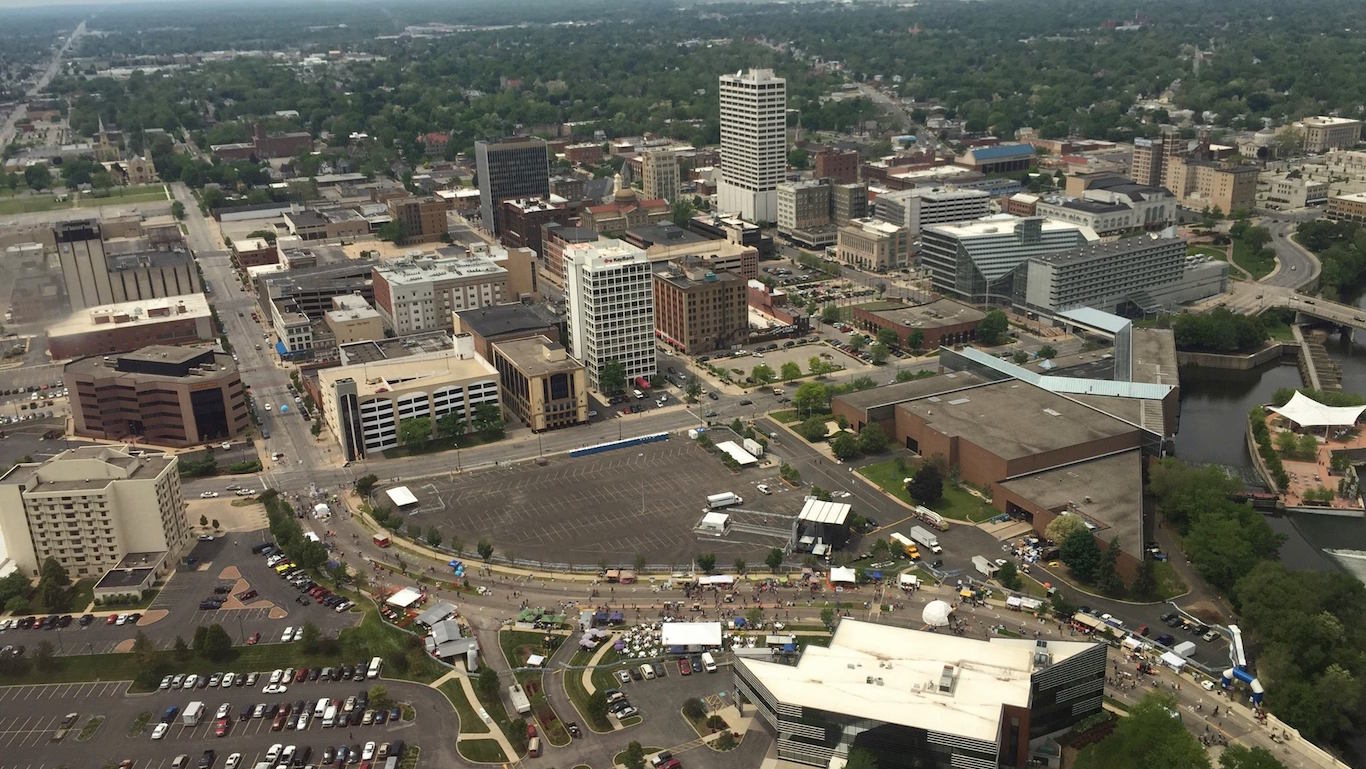
47. South Bend, Indiana
> Population: 103,757
> Median home value: $79,500
> Poverty rate: 25.9%
> Pct. with at least a bachelor’s degree: 22.8%
While South Bend was once a major manufacturing center, the sector has contracted over the past few decades as the industry declined nationwide. The typical household in South Bend today earns just $36,273 a year, far less than the $55,775 national figure. The city’s property values fell in tandem with the worsening economy and shrinking population, and the median home value in South Bend today is just $79,500, among the lowest of any large U.S. city.
The city’s population has declined substantially since peaking in 1960, due to suburbanization and the loss of manufacturing giants such as Studebaker and Oliver Farm Equipment. In recent years, however, the population has risen for the first time in nearly half a century, rising 7.0% between 2013 and 2015.
[in-text-ad-2]
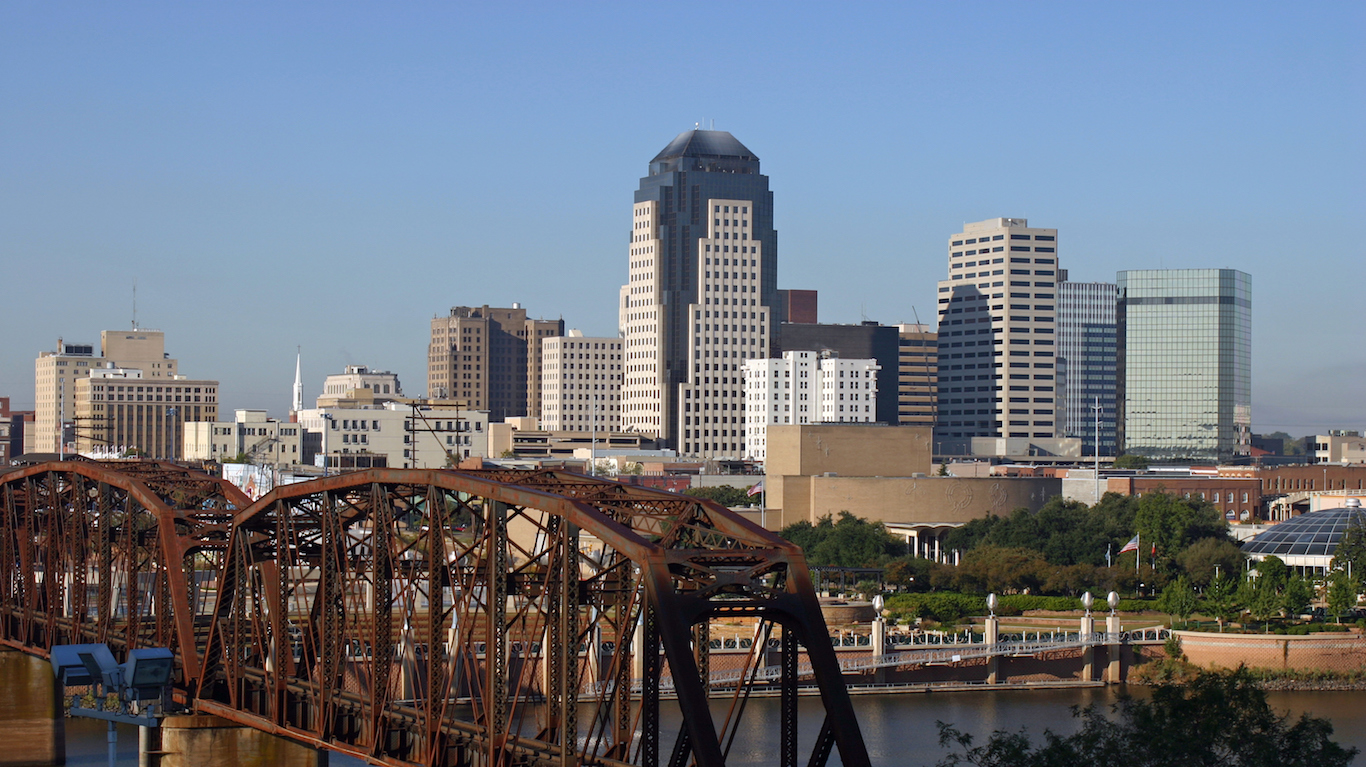
46. Shreveport, Louisiana
> Population: 196,994
> Median home value: $141,000
> Poverty rate: 23.4%
> Pct. with at least a bachelor’s degree: 24.9%
By many measures of quality of life, Shreveport is the worst city to live in Louisiana and among the worst nationwide. While the city’s economy thrived in the first half of the 20th century due to an active oil industry, today Shreveport’s economy is largely service-based and is battling high unemployment. The city’s unemployment rate of 7.1% is far higher than the state’s unemployment rate of 6.3% and the national rate of 5.3%.
In addition to high unemployment, Shreveport struggles with high crime and widespread poverty. There were 819 violent crimes reported per 100,000 residents in Shreveport in 2015, more than twice the national crime rate of 373 incidents per 100,000 Americans. Also, 23.4% of Shreveport residents live in poverty compared to 14.7% of Americans nationwide.
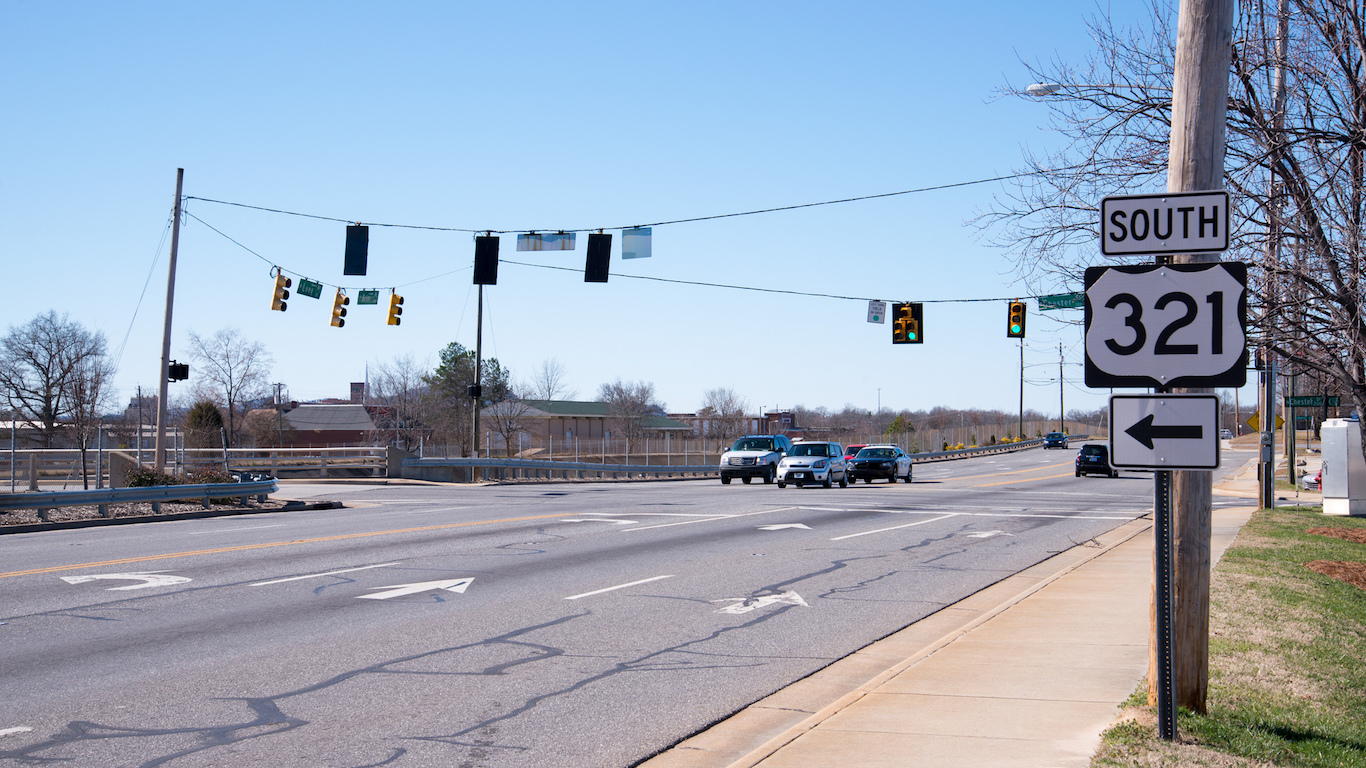
45. Gastonia, North Carolina
> Population: 74,551
> Median home value: $134,300
> Poverty rate: 19.7%
> Pct. with at least a bachelor’s degree: 23.0%
A suburb of the fast-growing Charlotte metropolitan area, Gastonia’s population has more than tripled in size since 1950. Despite the steady growth, Gastonia lags behind most U.S. cities in a number of quality of life measures. The city’s poverty rate of 19.7% is well above the nationwide rate of 14.7%. Also, there were 716 violent crimes reported per 100,000 Gastonia residents in 2015, one of the highest violent crime rates of any U.S. city.
While over the past few decades Charlotte economy has developed into a major banking and financial center, Gastonia has remained relatively dependent on manufacturing. U.S. manufacturing activity has declined in recent years, and a number of plant closings in Gastonia have contributed to job losses throughout the city. Gastonia’s annual unemployment rate of 6.2% is higher than the 5.3% national rate.
[in-text-ad]
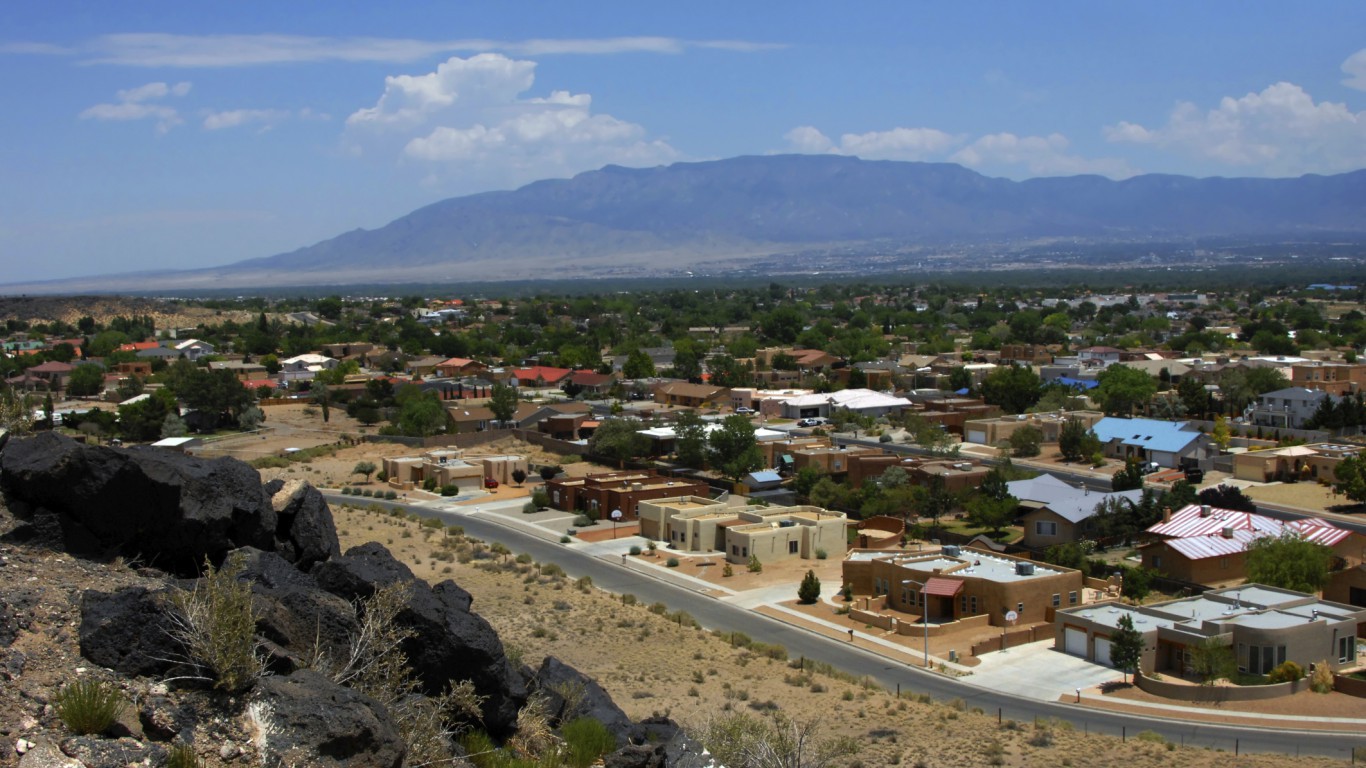
44. Albuquerque, New Mexico
> Population: 559,131
> Median home value: $189,200
> Poverty rate: 20.0%
> Pct. with at least a bachelor’s degree: 32.6%
Albuquerque is one of most dangerous cities in the country. There were 966 violent crimes reported per 100,000 Albuquerque residents in 2015, far more than double the national rate of 373 incidents per 100,000 Americans and among the most of any city in the country. Albuquerque also has missed out on much of the job growth that most mid-size cities enjoyed over the past few years, and it continues to struggle with high poverty. While total employment in the U.S. grew by 4.0% from 2013 to 2015, the number of jobs in Albuquerque increased by just 0.1% over the same period. The city’s poverty rate of 20.0% is much higher than the nationwide poverty rate of 14.7%.
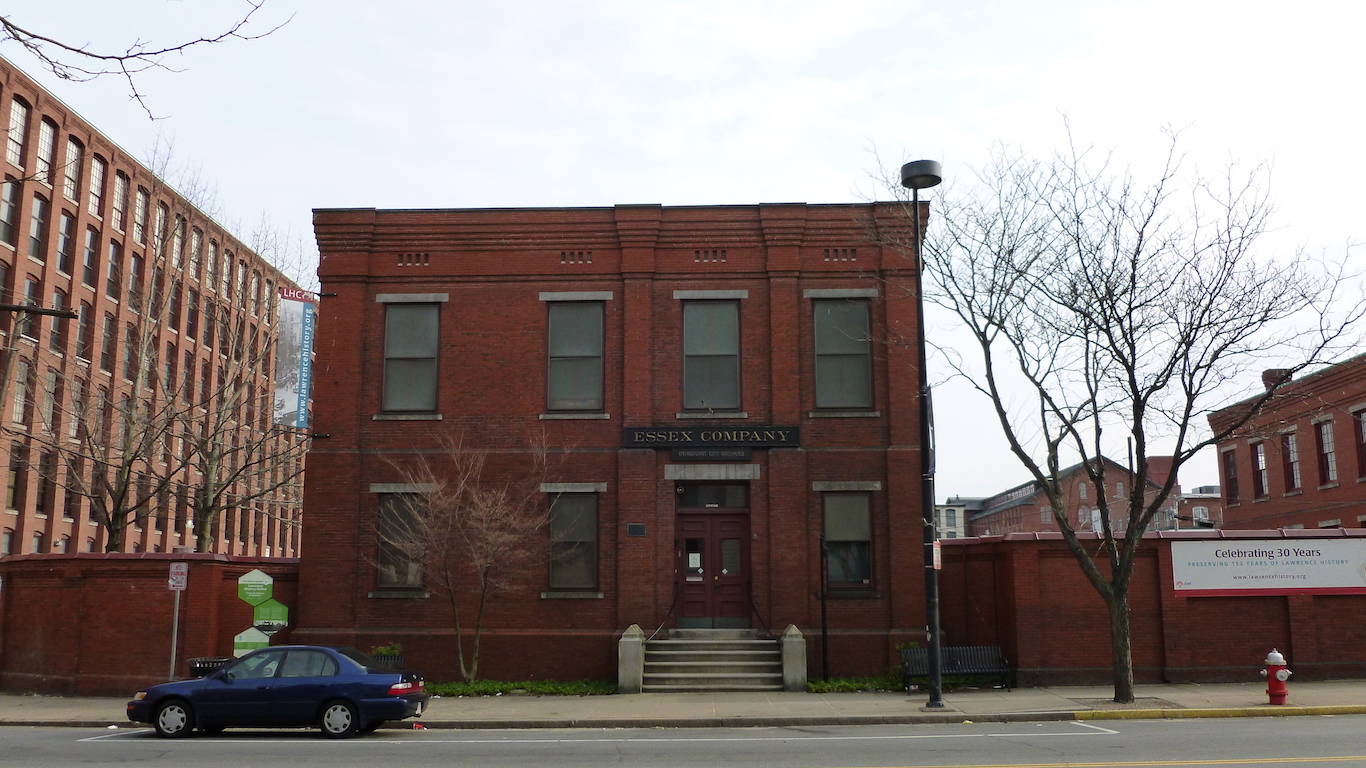
43. Lawrence, Massachusetts
> Population: 80,240
> Median home value: $254,800
> Poverty rate: 26.4%
> Pct. with at least a bachelor’s degree: 9.7%
A number of political and socioeconomic factors make Lawrence one of the worst places to live. While the median household income in Lawrence of $36,969 a year is relatively low, when adjusted for the high cost of living the figure is even lower. Goods and services cost 25% more in Lawrence than across the United States on average, and housing costs 56% more. While nationwide the typical home costs 3.5 times the median household income, in Lawrence the median home value of $254,900 is almost seven times the typical Lawrence household annual income.
Because of Lawrence’s poor tax base, as well as mismanagement of public funds by the city’s government, the city’s school system was placed in receivership in 2011, which transfers ownership of the schools to the state in order to avoid bankruptcy. While test scores and graduation rates have improved since, Lawrence Public Schools still underperform the state as a whole in most measures of academic success.

42. Philadelphia, Pennsylvania
> Population: 1,567,442
> Median home value: $150,700
> Poverty rate: 25.8%
> Pct. with at least a bachelor’s degree: 27.4%
The typical Philadelphia household earns only $41,233 a year, well below the statewide median income of $55,702. Goods and services are about 12% more expensive in Philadelphia than they are nationwide, and after adjusting for the city’s relatively high cost of living, the median income in Philadelphia is only about $41,200, one of the lowest of any U.S. city. Philadelphia’s status as one of the worst cities to live in is underscored by the city’s high poverty rate. More than one in four city residents live below the poverty line, well above the 14.7% U.S. poverty rate.
Philadelphia is also a relatively dangerous city. There were 1,029 violent crimes in the city for every 100,000 residents in 2015, nearly three times the violent crime rate nationwide.
[in-text-ad-2]
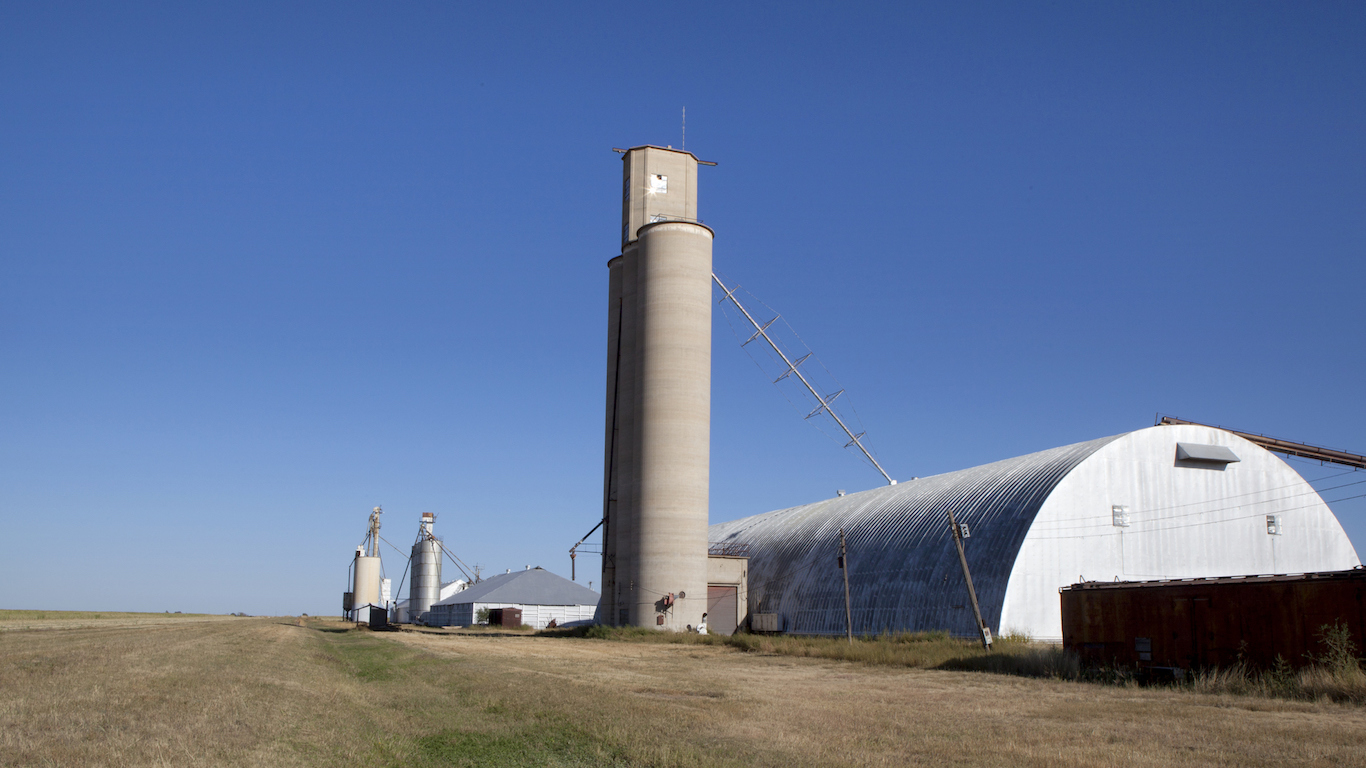
41. Lubbock, Texas
> Population: 249,051
> Median home value: $126,900
> Poverty rate: 22.4%
> Pct. with at least a bachelor’s degree: 26.8%
The typical household in Lubbock, Texas earns only $45,551 a year, about $10,000 less than the median income across the state. The city’s poverty rate underscores the prevalence of financial hardship in Lubbock. Some 22.4% of people in the city live in poverty, well above the 15.9% statewide poverty rate and 14.7% nationwide poverty rate.
Like many cities on this list, Lubbock is not an especially safe place. With 967 violent crimes in 2015 for every 100,000 area residents, violent crime is more than twice as common in Lubbock as it is across both Texas and the nation as a whole.

40. Medford, Oregon
> Population: 79,795
> Median home value: $232,400
> Poverty rate: 22.3%
> Pct. with at least a bachelor’s degree: 20.9%
The typical household in Medford earns $40,806 a year, less than the $55,775 national median household income. While incomes in Medford are higher when adjusted for the city’s low cost of groceries, utilities, and other goods, the cost of housing is 11% higher in Medford on average than it is nationwide. The median home value is $232,400, nearly six times the typical city household income. By comparison, the median home value nationwide is only 3.5 times the national median household income.
LIke many cities on this list, Medford struggles with crime. There were 6,115 property crimes per 100,000 Medford residents in 2015, the 12th highest property crime rate of any U.S. city.
[in-text-ad]
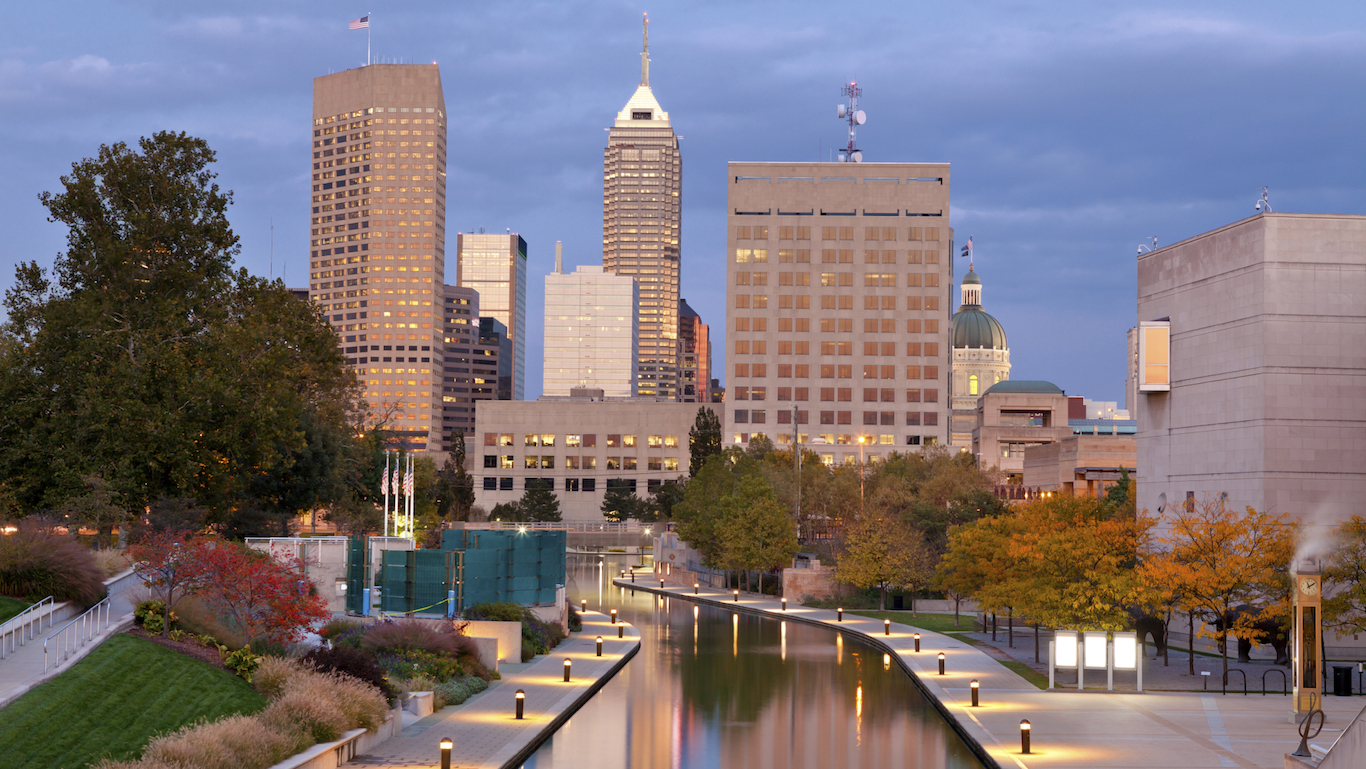
39. Indianapolis, Indiana
> Population: 848,423
> Median home value: $123,500
> Poverty rate: 20.6%
> Pct. with at least a bachelor’s degree: 29.4%
One of the most dangerous cities in the country, there were 1,288 violent crimes for every 100,000 Indianapolis residents in 2015, far more than the violent crime rate nationwide of 373 incidents per 100,000 Americans. With 144 homicides in the city, 2015 was the deadliest year in Indianapolis history up to that point. According to the Indianapolis Metropolitan Police Department, at least 28% of the murders were drug related.
Serious financial hardship is also more common in Indianapolis than it is across the state. More than one in five city residents live in poverty compared to Indiana’s poverty rate of 14.5%.
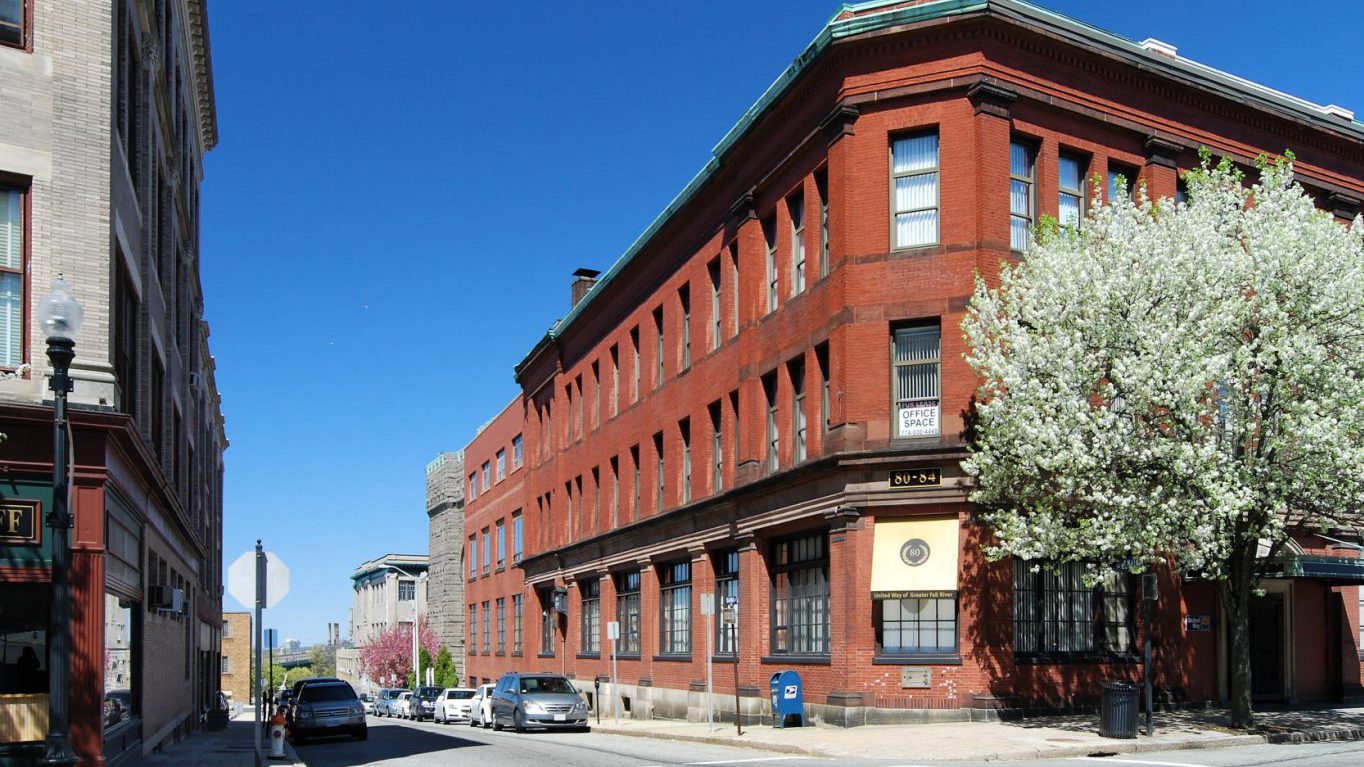
38. Fall River, Massachusetts
> Population: 88,770
> Median home value: $233,000
> Poverty rate: 21.5%
> Pct. with at least a bachelor’s degree: 13.5%
The typical Fall River household earns just $39,547 a year, far less than the $55,775 national median household income. Adjusted for the city’s high cost of groceries, transportation, healthcare, and housing, however, Fall River residents earn far less. While on a national level the typical U.S. home costs 3.5 times the U.S. median annual household income, in Fall River the typical home costs $233,000 — or nearly six times the typical city household income.
Like many cities in New England, Fall River is in the grips of a growing opioid epidemic. The city’s proximity to ports in neighboring New Bedford has been associated with the drug’s increasing availability, which has in turn contributed to a high violent crime rate. There were 1,141 violent crimes reported per 100,000 Fall River residents in 2015, the 22nd highest violent crime rate of any U.S. city.
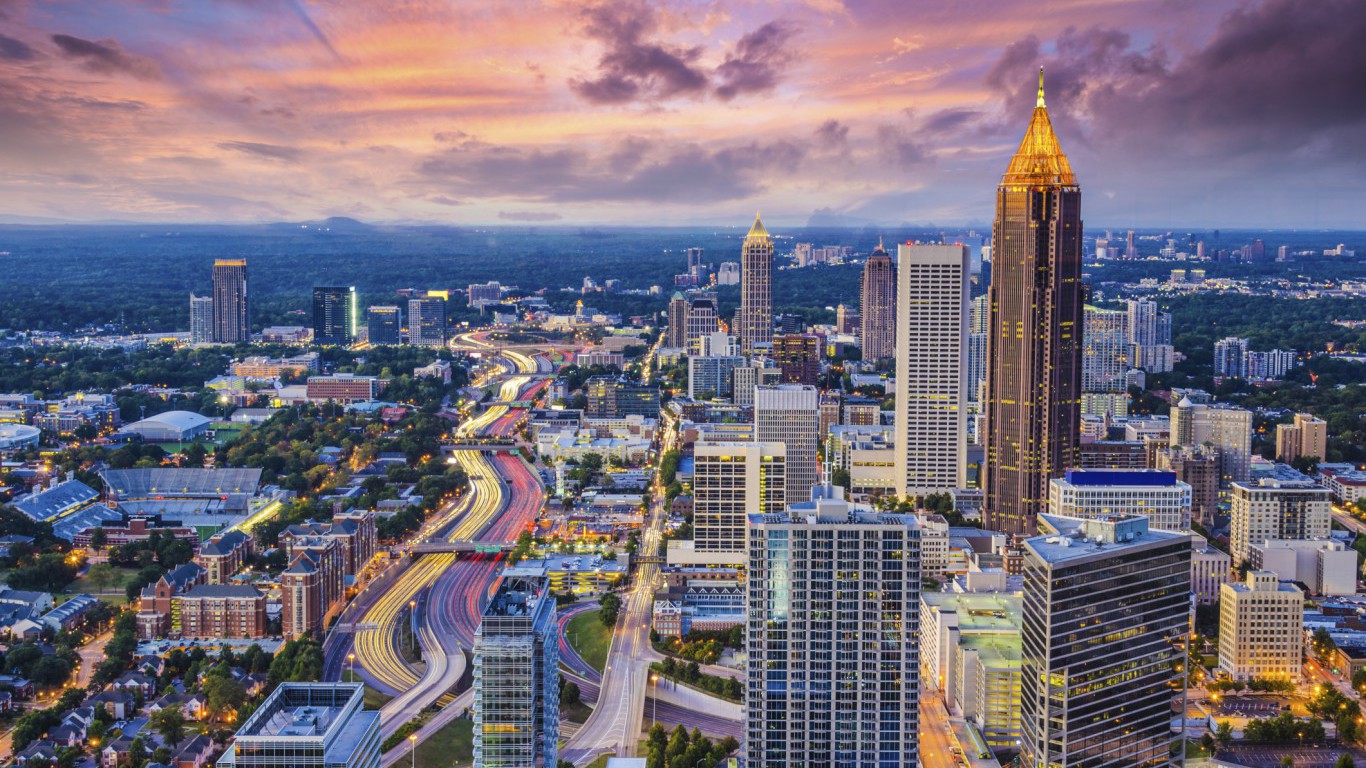
37. Atlanta, Georgia
> Population: 463,875
> Median home value: $241,200
> Poverty rate: 22.5%
> Pct. with at least a bachelor’s degree: 48.3%
As one of the most segregated places in the country, Atlanta also has one of the widest income disparities of any major U.S. city. While 11.2% of households earn less than $10,000 annually, 8.6% of households earn $200,000 or more — each share larger than the corresponding national figure. Similarly, while nearly every other adult in the city has a bachelor’s degree, which increases earnings by more than $20,000 on average, 22.5% of city residents live in poverty — one of the larger shares of any U.S. city.
While overall crime has fallen in recent years, Atlanta still struggles with one of the highest crime rates in the country. In 2015, 1,120 violent crimes were reported per 100,000 residents, more than three times the national rate of 373 incidents per 100,000 Americans.
[in-text-ad-2]

36. Waterbury, Connecticut
> Population: 108,807
> Median home value: $129,400
> Poverty rate: 27.3%
> Pct. with at least a bachelor’s degree: 13.1%
The typical Waterbury household earns only $37,877 a year, about $33,500 less than the median income across Connecticut as a whole. Goods and services are about 17% more expensive in the Waterbury area than they are nationwide, and when accounting for the high cost of living, the median household income in the city is only worth about $32,512. Homeowners in the area face the additional financial burden of a high tax rate. Typical homeowners pay about 3.7% of their home’s value in property taxes each year, the fifth highest share of any U.S. city and more than three times the 1.2% median property tax rate nationwide.
Pervasive joblessness underscores the area’s poor economic conditions. Some 9.3% of the city’s workforce is unemployed, well above the 5.3% U.S. unemployment rate.
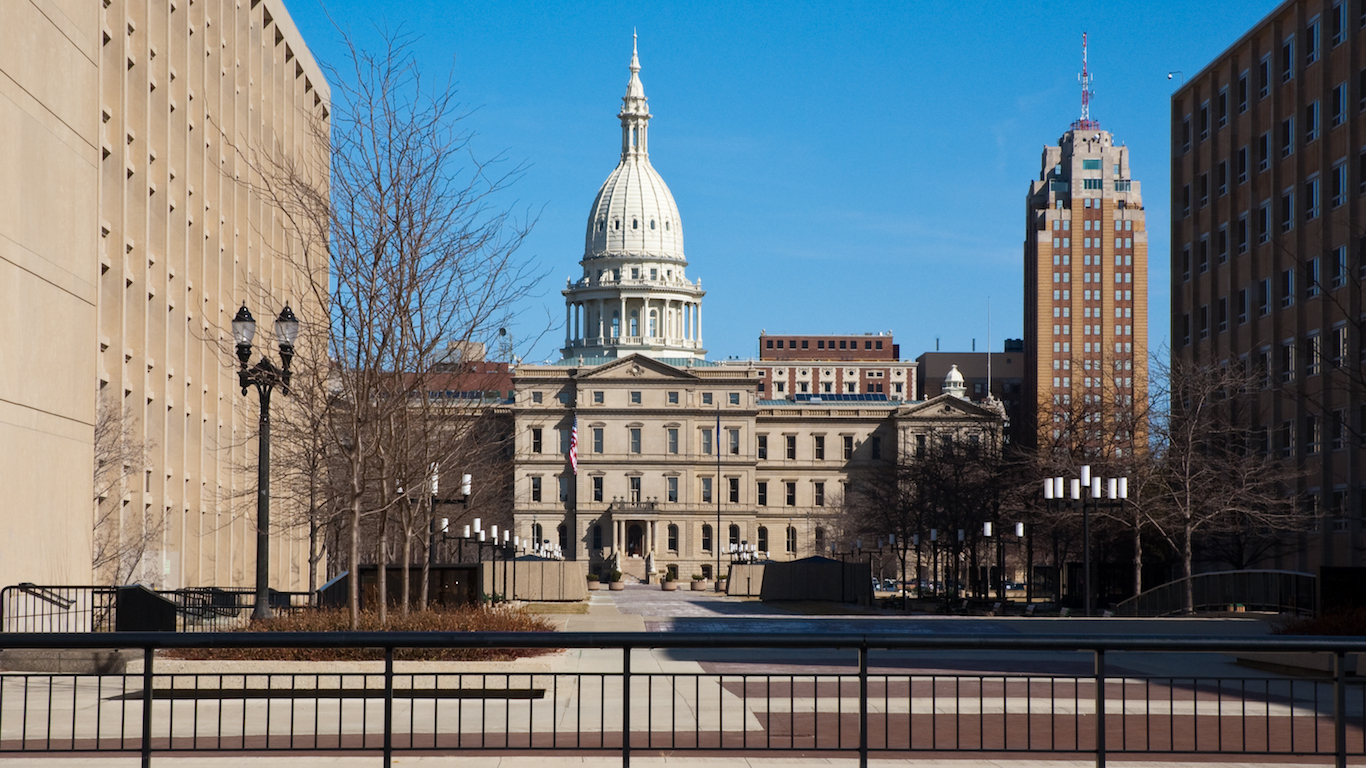
35. Lansing, Michigan
> Population: 114,110
> Median home value: $75,800
> Poverty rate: 26.8%
> Pct. with at least a bachelor’s degree: 26.0%
Typical in less desirable places to live, home values in Lansing are low. The median home value is only $75,800, 12th lowest of any U.S. city and less than half the $194,500 median home value nationwide. A dwindling population likely contributes to low home values in Lansing. The population has fallen by 4.7% over the last decade, even as the total U.S. population has climbed by 11.5%.
Like many cities on this list, Lansing is relatively dangerous. There were 1,157 violent crimes for every 100,000 city residents in 2015, one of the highest rates of U.S. cities and well more than double the statewide violent crime rate of 416 incidents per 100,000 people.
[in-text-ad]
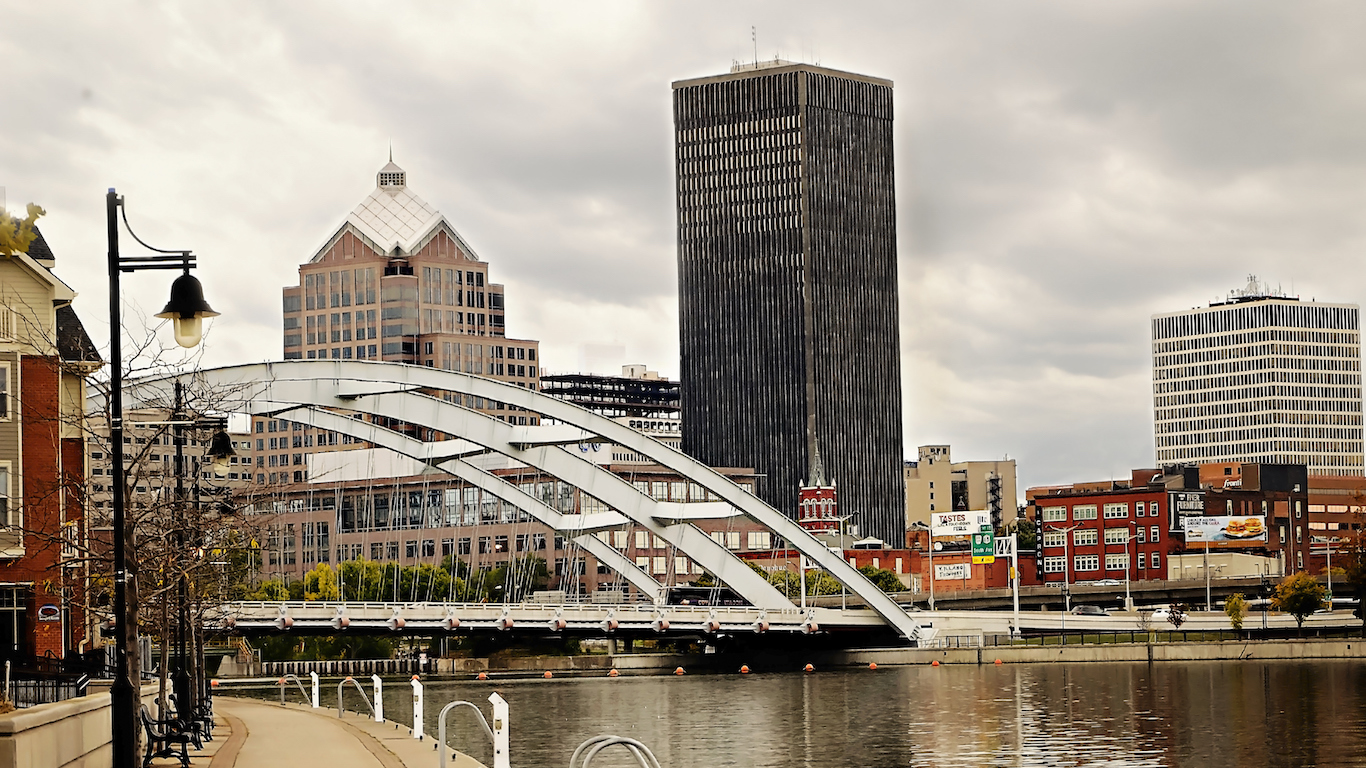
34. Rochester, New York
> Population: 209,808
> Median home value: $76,900
> Poverty rate: 33.2%
> Pct. with at least a bachelor’s degree: 21.6%
The typical Rochester household earns only $31,946 a year, slightly more than half the statewide median income of $60,850. In addition to very low incomes, serious financial hardship is relatively common in the western New York city. About one in three Rochester residents live in poverty, a higher poverty rate than in all but 14 other U.S. cities.
Property values in Rochester are very low on average. More than half of all homes in the city are worth less than $77,000, one of the lowest median property values in the country. High property taxes saddle area residents with additional financial burdens. Homeowners pay 3.3% of their home value in property taxes on average on an annual basis, far higher than the 1.2% the typical American homeowner pays.

33. Reading, Pennsylvania
> Population: 87,873
> Median home value: $69,100
> Poverty rate: 38.8%
> Pct. with at least a bachelor’s degree: 11.5%
Once a prosperous industrial center, Reading’s economy and standard of living has declined since Reading Company, operator of the main coal transporting railroad in the area, declared bankruptcy in 1971. The city’s population declined in the following years but has grown steadily over the past few decades. Still, Reading’s population has yet to return to its 1930 peak of 111,000 people.
Today, Reading is one of the poorest of U.S. cities. Just 11.5% of adults have a bachelor’s degree, less than half of the 30.6% national figure. With such low earnings potential, the city’s typical household earns just $26.531 a year, less than half the national median household income of $55,775. Reading’s poverty rate of 38.8% is the fifth highest of any U.S. city.

32. Salt Lake City, Utah
> Population: 192,660
> Median home value: $262,400
> Poverty rate: 19.1%
> Pct. with at least a bachelor’s degree: 44.4%
While Salt Lake City has a growing economy, and is home to a large share of college graduates and low unemployment, the city struggles with frequent crime and unaffordable housing. The median home value in Salt Lake City is $262,400, 5.4 times the city’s median annual household income of $48,761. By comparison, the U.S. median home value is only 3.5 times higher than the typical American household income.
In 2015, there were 9,331 property crimes — burglary, larceny-theft, motor vehicle theft, and arson — per 100,000 Salt Lake City residents, a higher property crime rate than any city other than Miami Beach. While not as prevalent as property theft, violent crime is also relatively common in the city. There were 855 violent crimes per 100,000 Salt Lake City residents, more than twice the national rate of 373 incidents per 100,000 Americans.
[in-text-ad-2]

31. Syracuse, New York
> Population: 144,152
> Median home value: $93,100
> Poverty rate: 31.0%
> Pct. with at least a bachelor’s degree: 29.0%
An economic powerhouse in the industrial era, Syracuse has been in decline for decades. Today, some 31.0% of Syracuse residents live in poverty, roughly double the New York state poverty rate of 15.4%. The high poverty rate is likely fueled, in part, by a struggling job market. The city’s annual unemployment rate of 6.6% is well above the statewide unemployment rate of 5.3%. Total employment in the city fell by about 1% between 2013 and 2015, even as employment nationwide climbed 4% over the same time period.
Often indicative of less desirable places to live, property is relatively cheap in Syracuse. The typical area home is worth only $93,100, less than a third of the statewide median home value of $293,500.

30. Chattanooga, Tennessee
> Population: 176,597
> Median home value: $151,400
> Poverty rate: 21.7%
> Pct. with at least a bachelor’s degree: 26.0%
Job growth is an important indicator of a city’s prosperity and economic potential, and in Chattanooga job growth has been stagnant. While total U.S. employment grew by 4% between 2013 and 2015, employment in the city increased by just 0.4% over the same period — less than over 500 of the 551 cities considered.
Another unfavourable feature is Chattanooga’s high crime. There were nearly 1,000 violent crimes and about 5,900 property crimes in the city per 100,000 residents in 2015, well above the national rates of 373 violent crimes and 2,487 property crimes per 100,000 people.
[in-text-ad]
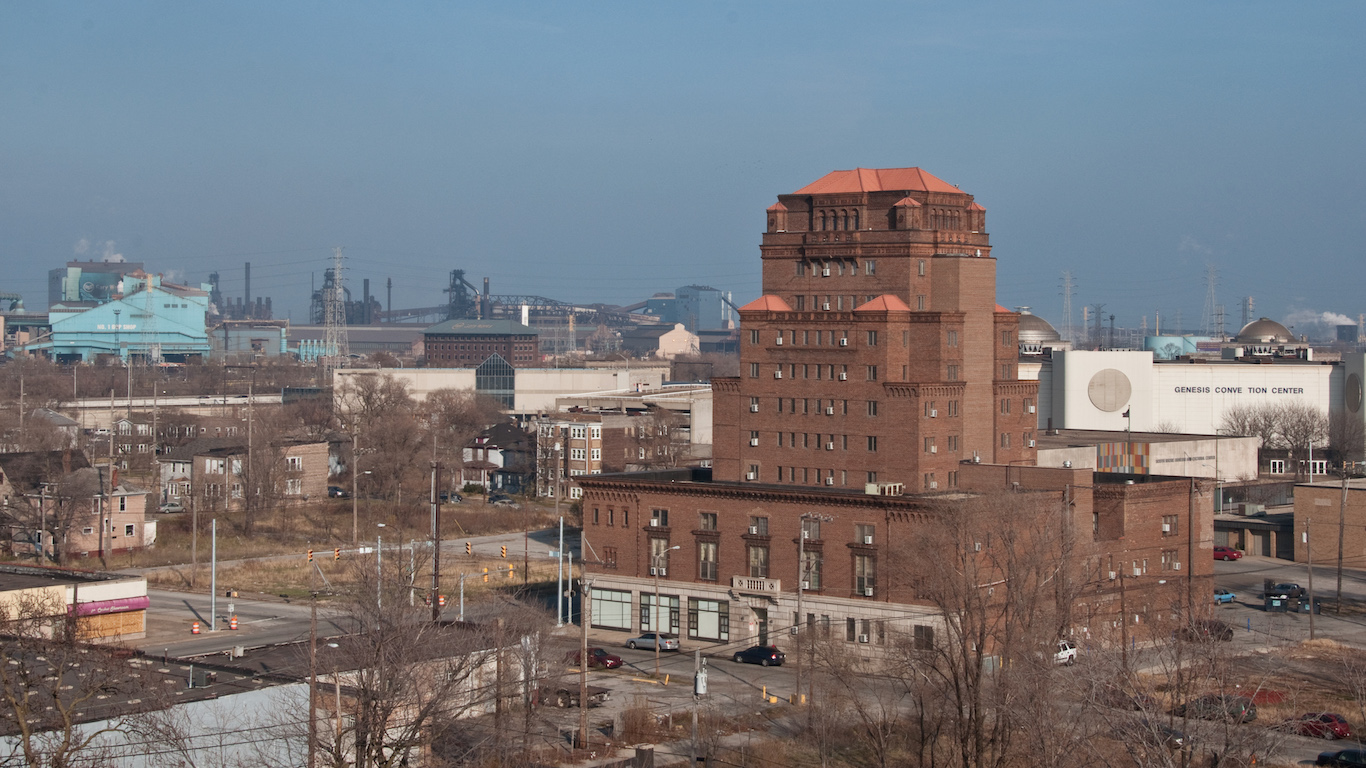
29. Gary, Indiana
> Population: 77,354
> Median home value: $68,000
> Poverty rate: 29.8%
> Pct. with at least a bachelor’s degree: 12.6%
A the typical home in Gary, Indiana is worth only $68,000, the eighth lowest median home value of any city in the country. The low property values are likely the result, in part, of the city’s dwindling population. Over the past decade, Gary’s population has fallen by 20.3%, the steepest drop of any U.S. city over that period.
A stagnant job market is not helping economic conditions in Gary. Nearly one in every 10 workers in the city are out of a job, more than double the 4.8% statewide unemployment rate. The bleak economic picture is underscored by the relative lack of small businesses such as restaurants, bodegas, and cafes. There are only about 80 of these establishments for every 100,000 city residents, one of the smallest concentration of any city and well below the 165 per 100,000 nationwide concentration.
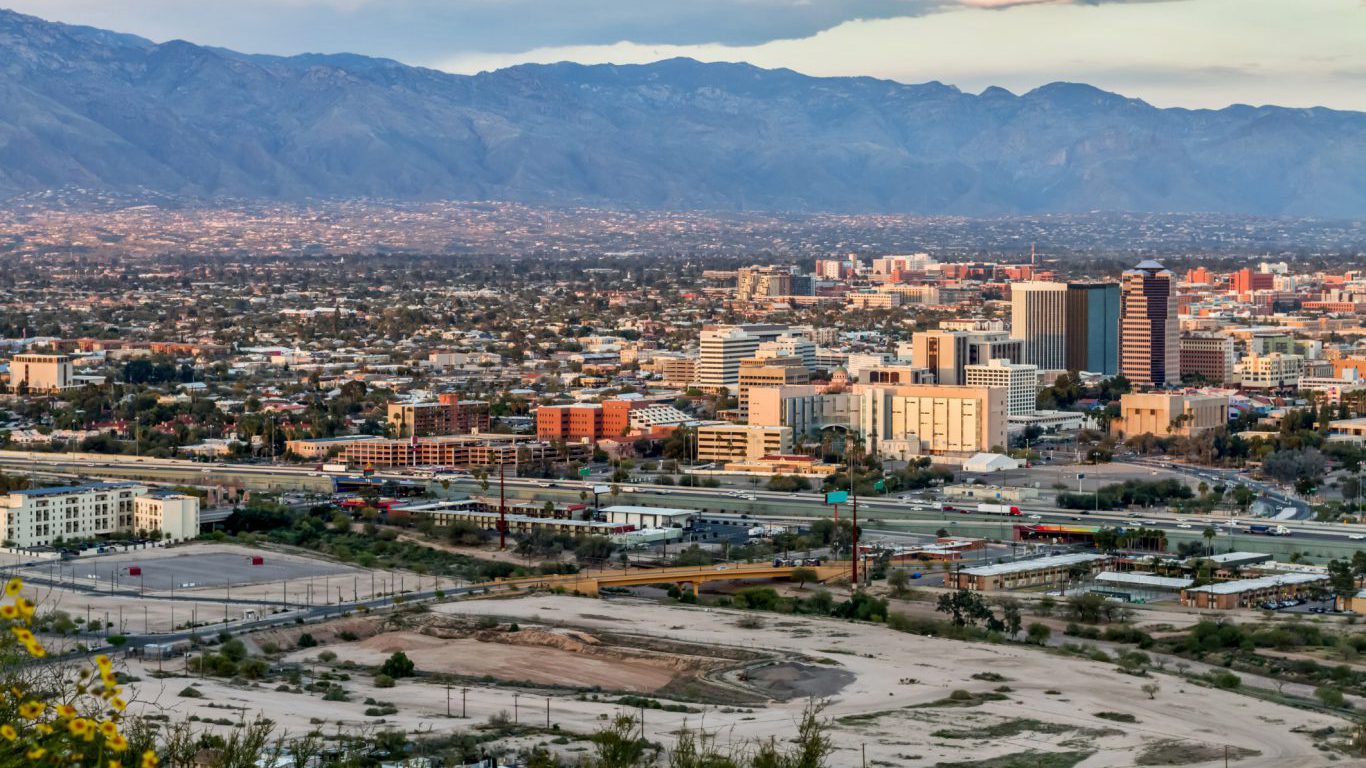
28. Tucson, Arizona
> Population: 531,674
> Median home value: $139,400
> Poverty rate: 25.2%
> Pct. with at least a bachelor’s degree: 26.5%
Tucson is one of the only cities in the Southwest to rank among the worst places to live. The city’s poverty rate of 25.2% is far higher than the national poverty rate of 14.7%. Tucson’s economy has grown slower than most cities’ in recent years, and unemployment in the area remains slightly above the national rate. The number of jobs in Tucson rose by just 2.1% from 2013 to 2015, roughly half the national employment growth over the same period.
Tucson also struggles with one of the highest property crime rates in the country. There were 6,643 property crimes reported per 100,000 Tucson residents in 2015, more than double the national rate of 2,487 incidents per 100,000 Americans. According to one local criminologist, the high prevalence of property crime may be due to the transient nature of many Tucson residents. While the average American moves every 5.2 years, the average Tucson resident moves every 3.5 years. The population mobility makes it difficult to establish a strong community, which is one of the best defenses against property crime.

27. Paterson, New Jersey
> Population: 147,757
> Median home value: $226,300
> Poverty rate: 30.1%
> Pct. with at least a bachelor’s degree: 9.1%
A college education can greatly increase an individual’s earning power, and in Paterson, only 9.1% of adults have a bachelor’s degree — less than a third of the 30.6% national share. The low educational attainment partially explains the low incomes in the area. The typical Patterson household earns only $31,552 a year, less than half the statewide median income of $72,222. Further, goods and services are on average about 28% more expensive in the Paterson area than they are nationwide, and when accounting for the high cost of living, the city’s median household income is only worth about $24,650. Area residents face an additional financial burden of high taxes. Homeowners pay 3.8% of their home value on average in taxes annually, more than three times the 1.2% share the typical American homeowner pays in taxes.
[in-text-ad-2]

26. Little Rock, Arkansas
> Population: 197,986
> Median home value: $162,000
> Poverty rate: 19.2%
> Pct. with at least a bachelor’s degree: 39.7%
Little Rock has a long history of segregation, which has contributed to income inequality in the city. While 9.7% of households in the city earn less than $10,000 annually, 7.0% of households earn at least $200,000 — each larger than the corresponding national shares. While areas like the River Market district have been revitalized in recent years, many neighborhoods to the south and east of Interstate 30 are run-down and impoverished. About 40% of adults in the city have a bachelor’s degree, one of the higher such shares among U.S. cities. And workers with a bachelor’s degree earn over $20,000 more on average than those with only a high school diploma. At the same time, nearly 20% of city residents live in poverty, one of the higher poverty rates of U.S. cities.
Little Rock has one of the highest crime rates in the country. There were 1,485 violent crimes and 6,471 property crimes reported per 100,000 Little Rock residents in 2015, far more than the corresponding national rates of 373 violent and 2,487 property crimes per 100,000 Americans.

25. Cincinnati, Ohio
> Population: 298,537
> Median home value: $119,000
> Poverty rate: 27.4%
> Pct. with at least a bachelor’s degree: 34.3%
Cincinnati is a relatively dangerous city. There were 925 violent crimes for every 100,000 city residents in 2015, more than double the national violent crime rate of 373 incidents per 100,000 Americans. Experts partially attribute the city’s crime problem to the availability of guns — which are often available on the streets for less than $100 — as well as a shortage of drugs, which is sparking turf wars. The prevalence of violent crime in the city led to the 2015 firing of Cincinnati Police Chief Jeffrey Blackwell.
Though the 34.2% share of city residents with at least a bachelor’s degree is slightly larger than the 30.6% U.S. rate, the typical Cincinnati household earns only about $35,000 a year, well below the $55,775 median income nationwide.
[in-text-ad]
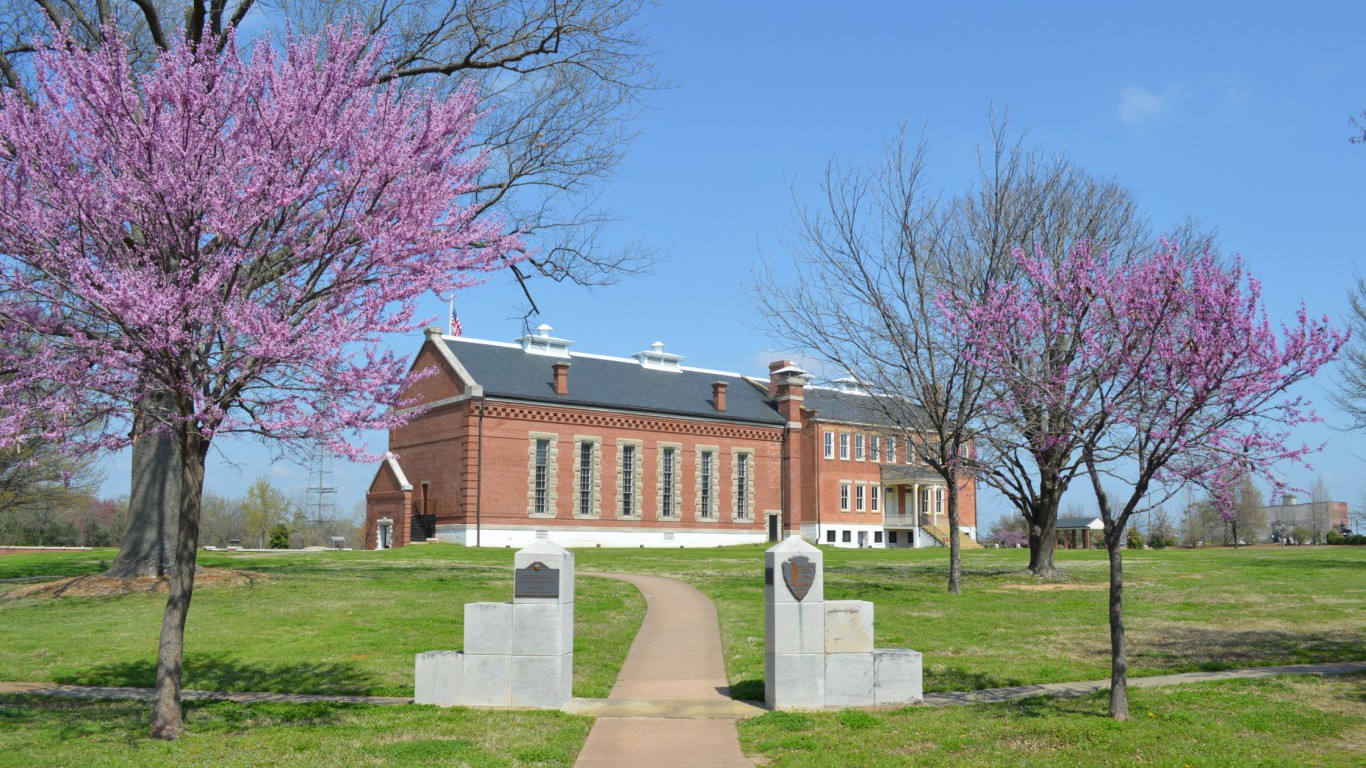
24. Fort Smith, Arkansas
> Population: 88,195
> Median home value: $116,300
> Poverty rate: 29.8%
> Pct. with at least a bachelor’s degree: 19.0%
The typical Fort Smith household earns just $33,534 a year, far less than the national median household income of $55,775. While area incomes are higher when adjusted for the city’s low cost of living, a larger-than-average share of residents earn poverty wages. Some 29.8% of Fort Smith residents live in poverty, nearly double the 14.7% national poverty rate. One factor contributing to low earnings in Fort Smith may be the low educational attainment among city residents. Just 19.0% of adults in Fort Smith have a bachelor’s degree compared to 30.6% of adults nationwide.
Fort Smith is also one of the most dangerous places in the United States. There were 804 violent crimes and 5,892 property crimes per 100,000 city residents in 2015, well more than double the corresponding national rates of 373 violent crimes and 2,487 property crimes per 100,000 Americans.
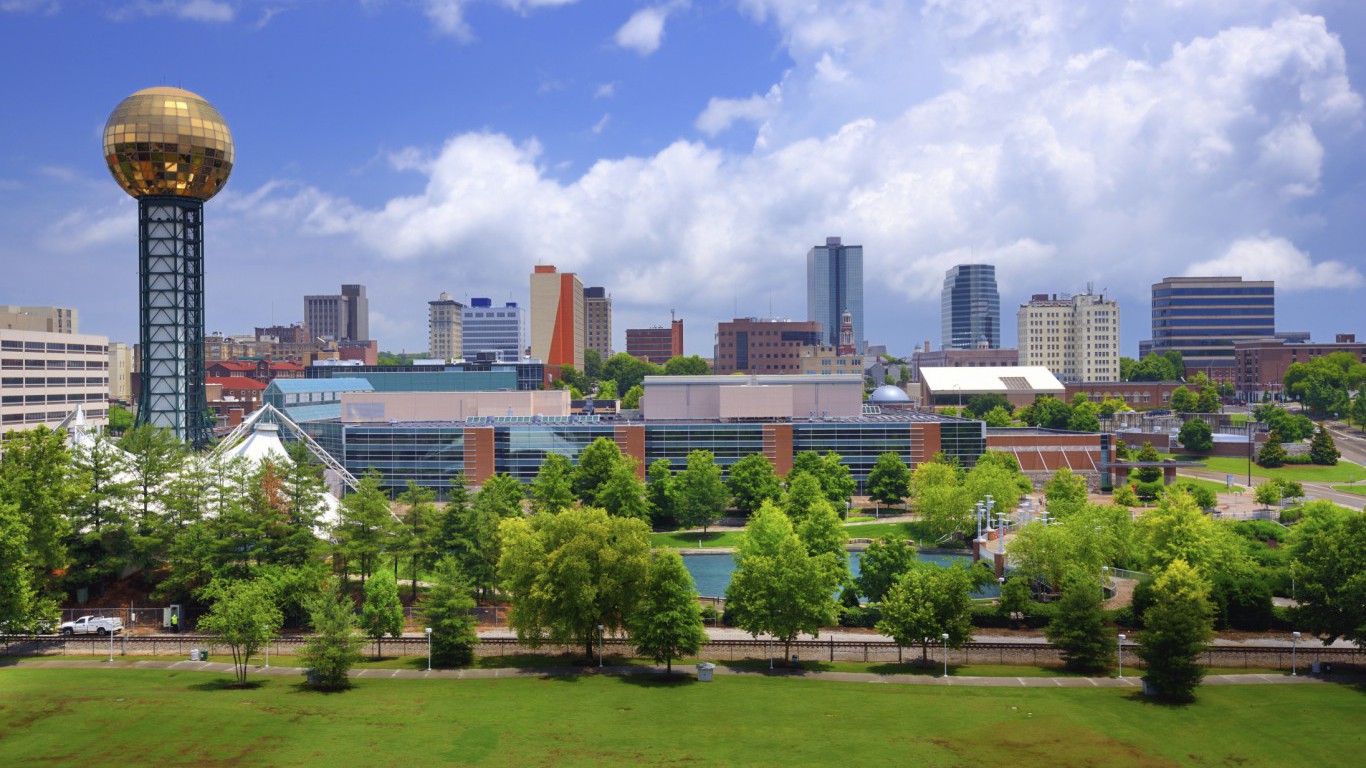
23. Knoxville, Tennessee
> Population: 185,312
> Median home value: $125,900
> Poverty rate: 25.8%
> Pct. with at least a bachelor’s degree: 29.2%
More than one in four Knoxville residents live in poverty, a far larger share than the nationwide poverty rate of 14.6%. As is common in economically depressed areas, crime is high in Knoxville. There were about 6,000 property crimes such as arson, burglary, and vehicle theft for every 100,000 Knoxville residents in 2015, one of the highest property crime rates of any U.S. city and more than double the U.S. property crime rate that year.
Violent crime is also prevalent in Knoxville. There were 927 violent crimes in the city in 2015 per 100,000 people, including aggravated assaults, robberies, and murders. Police attribute many of the fatal shootings to gang violence.
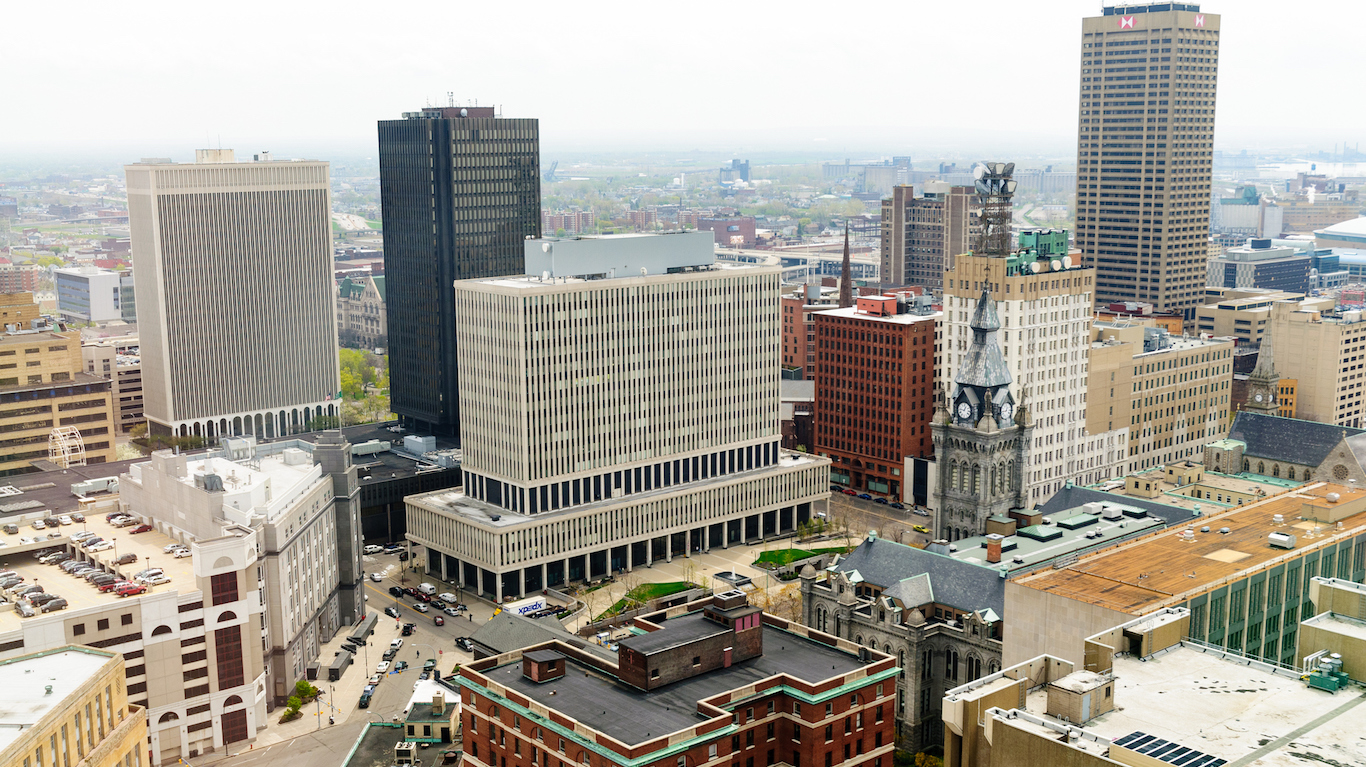
22. Buffalo, New York
> Population: 258,066
> Median home value: $75,800
> Poverty rate: 33.0%
> Pct. with at least a bachelor’s degree: 23.9%
Buffalo is the second largest city in New York, and by many measures the most economically and socially distressed. The typical Buffalo household earns only $32,509 a year, and about one in three area residents live below the poverty line. In comparison, the median annual household income across the state is $60,850, and about 15.4% of state residents live in poverty. Financial prosperity is undercut by a lack of employment opportunities. The city’s 7.1% unemployment rate is the highest of any city in the state and well above the 5.3% statewide rate.
An economic turnaround may be in the city’s near future, however. In a joint venture with Tesla, Panasonic invested several hundred million dollars in a South Buffalo solar cell manufacturing plant. Once the plant hits production capacity in 2019, the venture is anticipated to add some 1,400 new jobs. The deal is one of several major investments that have been announced in the last few years.
[in-text-ad-2]

21. Youngstown, Ohio
> Population: 64,609
> Median home value: $42,600
> Poverty rate: 35.7%
> Pct. with at least a bachelor’s degree: 12.1%
Once among the largest steel manufacturers in the United States, Youngstown is emblematic of the decline and urban decay that has taken hold in many Midwestern cities since the industry collapsed in the latter half of the 20th century. The city’s population plateaued at around 170,000 people between 1930 and 1960, and has steadily declined since. While the U.S. population grew 3.9% over the past five years, the number of residents in Youngstown fell 3.3%.
Today, the typical Youngstown household earns just $23,984 a year, less than half the national median household income of $55,775. The unemployment rate remains high at 7.7%, and more than one in three Youngstown residents live in poverty. The city’s industrial legacy may also have lingering effects on the region’s air quality. Mahoning County has good air quality for approximately 338 days out of the year on average, less than the U.S. as a whole.
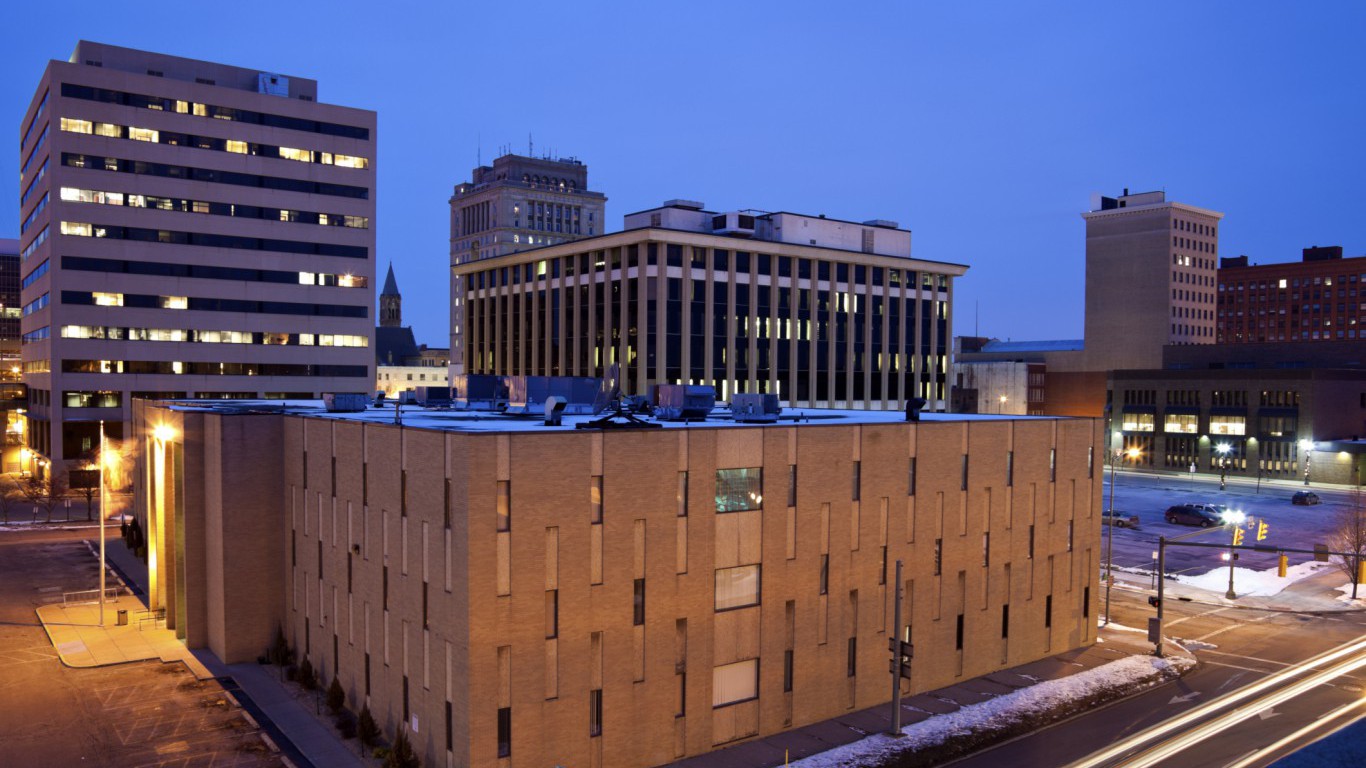
20. Canton, Ohio
> Population: 71,895
> Median home value: $62,700
> Poverty rate: 31.6%
> Pct. with at least a bachelor’s degree: 14.4%
In Canton, Ohio nearly one-third of residents live in poverty, more than double the national poverty rate. Prevalent poverty has wide-reaching effects on a city’s overall standard of living and economy. For example, violent crime rates tend to be higher in poor cities. Canton’s violent crime rate of 1,129 incidents per 100,000 residents is about three times worse than the national violent crime rate.
Low educational attainment in an area can coincide with many other negative quality of life-outcomes, including lower incomes and higher unemployment. In Canton, just 14.4% of adults have a bachelor’s degree, less than half the national bachelor’s attainment rate.
[in-text-ad]
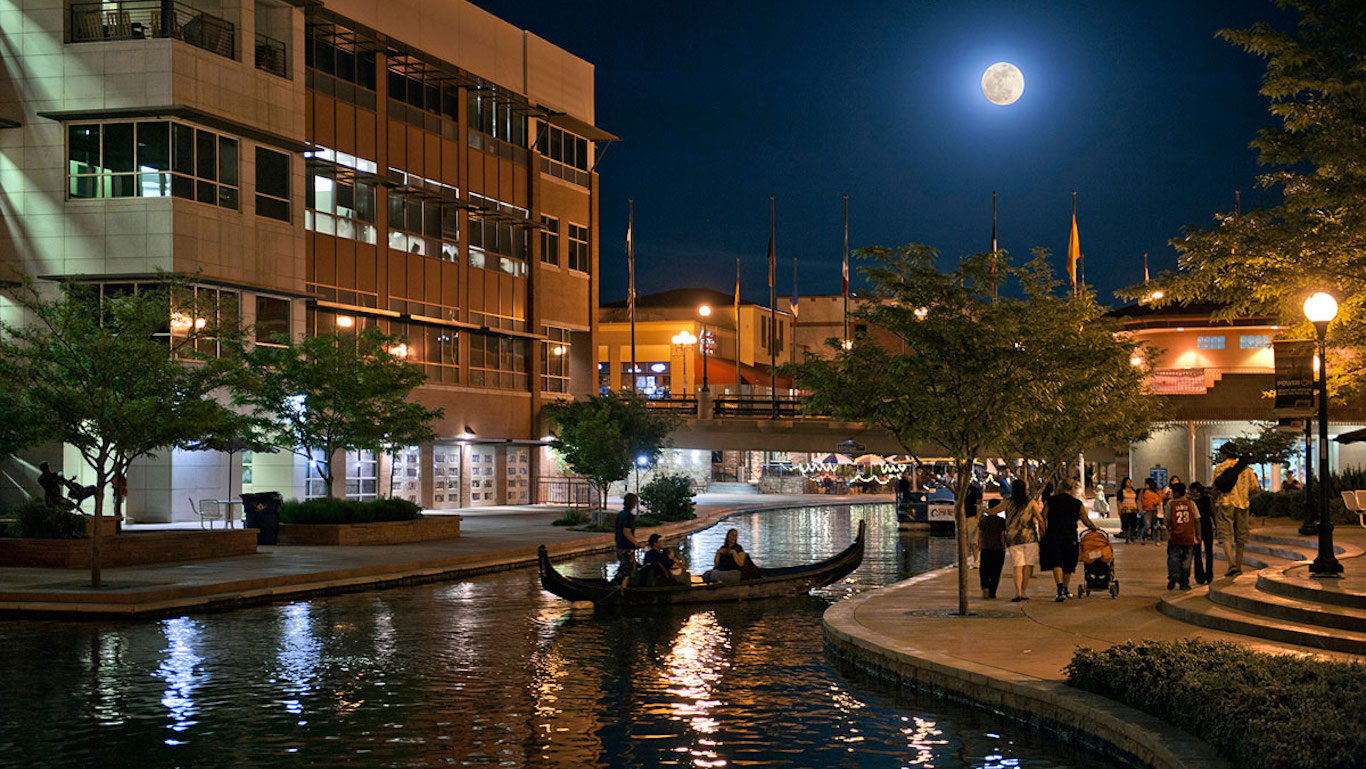
19. Pueblo, Colorado
> Population: 109,419
> Median home value: $124,700
> Poverty rate: 25.1%
> Pct. with at least a bachelor’s degree: 18.4%
The presence of institutions of higher education — colleges and universities — can create employment opportunities and often results in greater regional educational attainment. There are just two colleges or universities in Pueblo County, among the least of any county when adjusted for population.
Just 18.4% of the adults living in Pueblo have a bachelor’s degree, far less than the 30.6% national college attainment rate. Lower education attainment rates often result in lower incomes, and Pueblo is no exception. One in four of Pueblo’s 109,000 residents live in poverty, compared to approximately one in seven Americans nationwide The typical household in the city earns just $43,000 a year, or $13,000 less than the U.S. median household income.
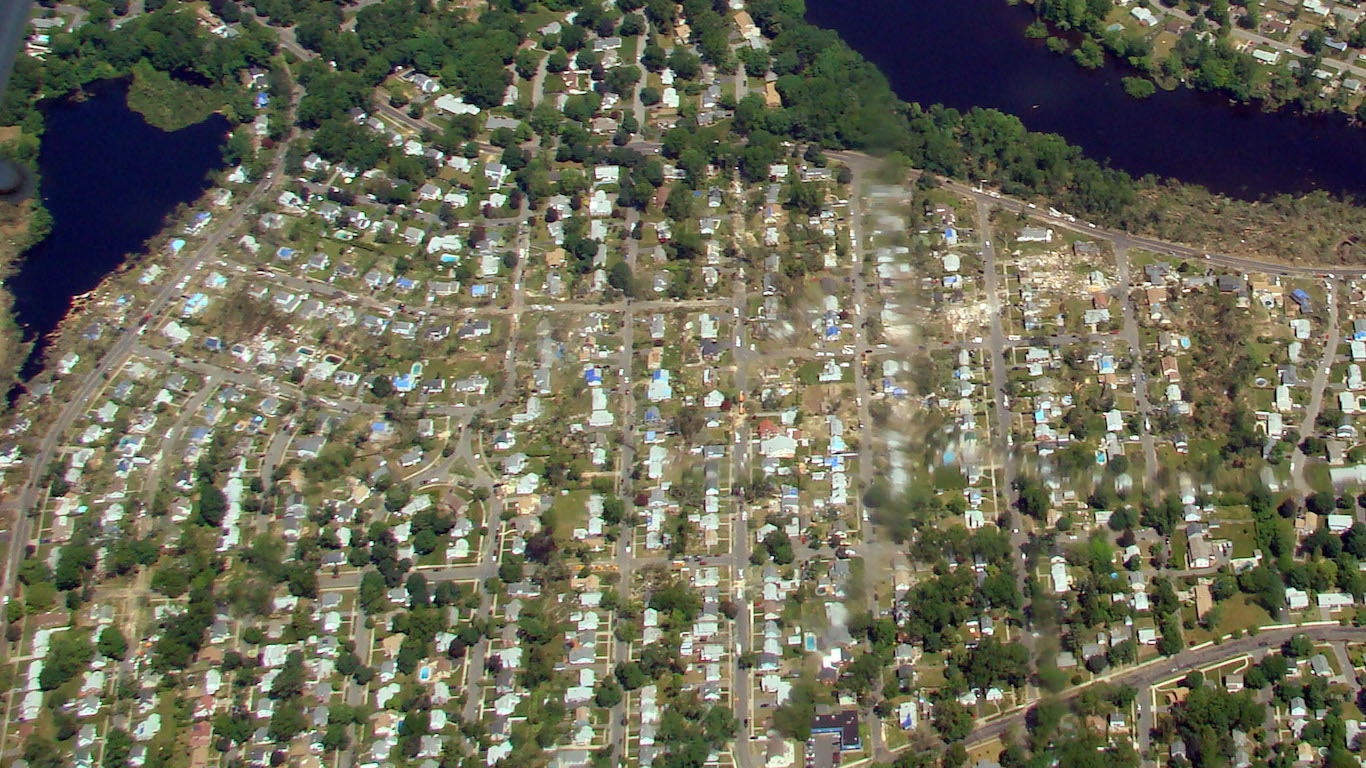
18. Springfield, Massachusetts
> Population: 154,336
> Median home value: $146,700
> Poverty rate: 27.3%
> Pct. with at least a bachelor’s degree: 17.5%
Springfield is one of the poorest cities in Massachusetts. A typical city household earns just $35,653 a year, about $20,000 less than the typical American household. The city’s poverty rate of 27.3% is the highest in the state and nearly double the national poverty rate.
Springfield also has one of the worst job markets in the country. The city’s two-year job growth is below average, and its unemployment rate of 9.3% is tied for 16th highest out of the 551 U.S. cities reviewed.
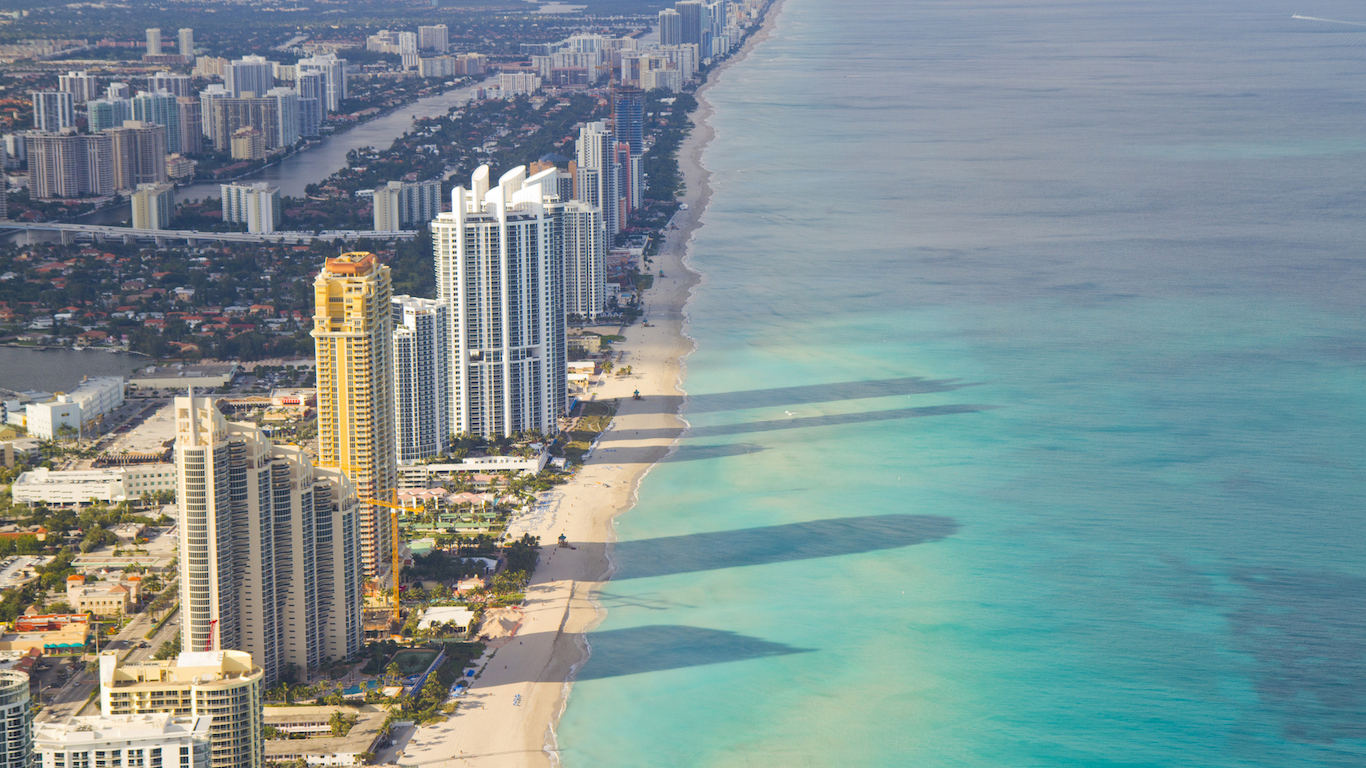
17. Miami Beach, Florida
> Population: 92,311
> Median home value: $460,000
> Poverty rate: 15.1%
> Pct. with at least a bachelor’s degree: 48.1%
While Miami Beach has some of the most expensive homes in country, a large share of city residents earn poverty wages. Miami Beach has a long history of segregation, which has contributed to income inequality throughout the city. While 9.9% of households in Miami Beach earn less than $10,000 annually, 13.7% of households earn at least $200,000 — each larger than the corresponding national shares.
The typical household in Miami Beach earns $50,937 annually, slightly less than the $55,775 national figure. Adjusted for the city’s high cost of living, however, area incomes are far lower. The typical home in Miami Beach costs $460,000, nine times the city’s median household income. In addition to being one of the least affordable U.S. cities, Miami Beach is one of the most dangerous. There were 1,077 violent crimes per 100,000 residents in 2015, among the most of any city. There were also 9,717 property crimes per 100,000 residents, the highest property crime rate nationwide.
[in-text-ad-2]
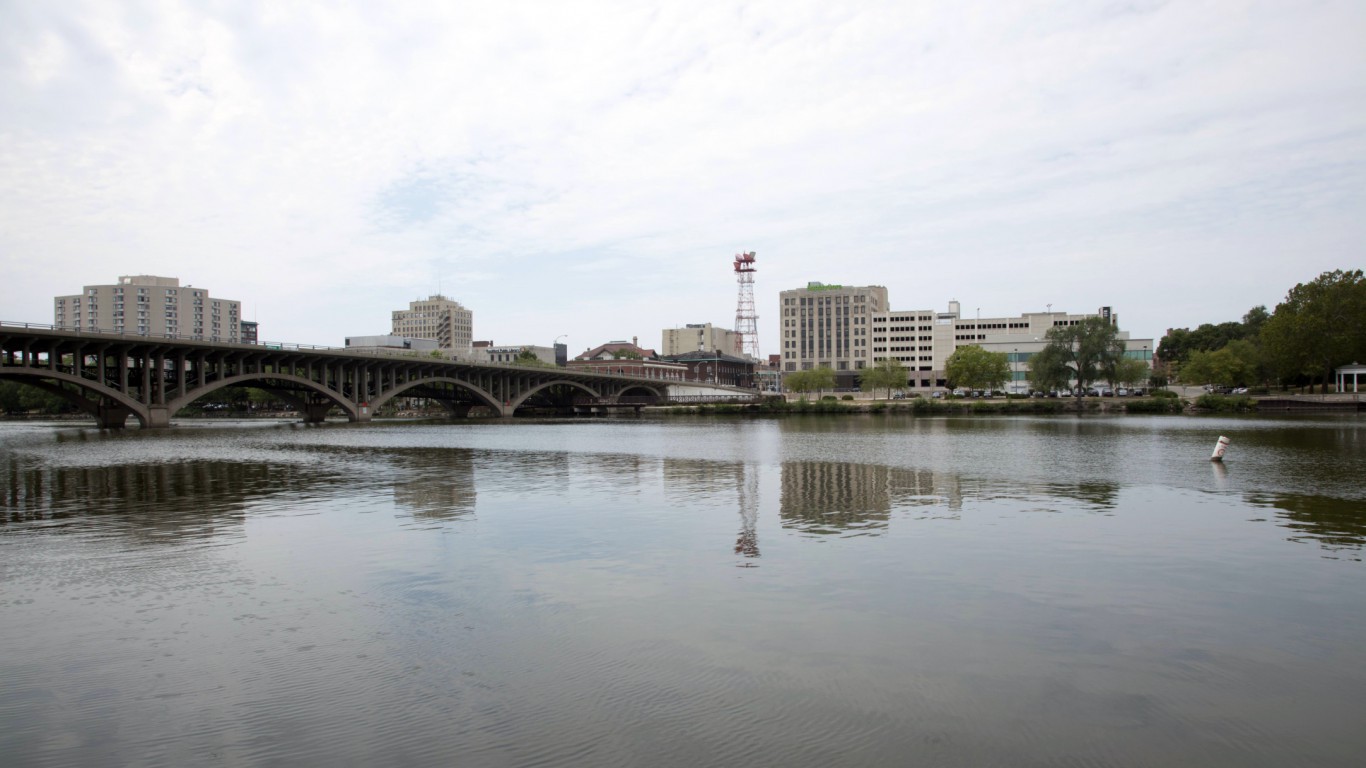
16. Rockford, Illinois
> Population: 149,346
> Median home value: $87,200
> Poverty rate: 22.4%
> Pct. with at least a bachelor’s degree: 20.9%
Property is very inexpensive in Rockford, Illinois. The typical home is worth just $87,200, less than half the national median home value of $194,500. While affordable housing can be positive for residents looking to buy a home, it is often indicative of economic and social difficulties. For example, some 8.3% of the city’s workforce is out of a job, and 22.4% of area residents live below the poverty line — each among the higher shares in the U.S.
Like many of the cities on this list, Rockford also struggles with crime. The northern Illinois city’s annual violent crime rate of 1,585 incidents for every 100,000 residents is over four times the national violent crime rate and ranks among the 10 worst out of the 551 cities considered.
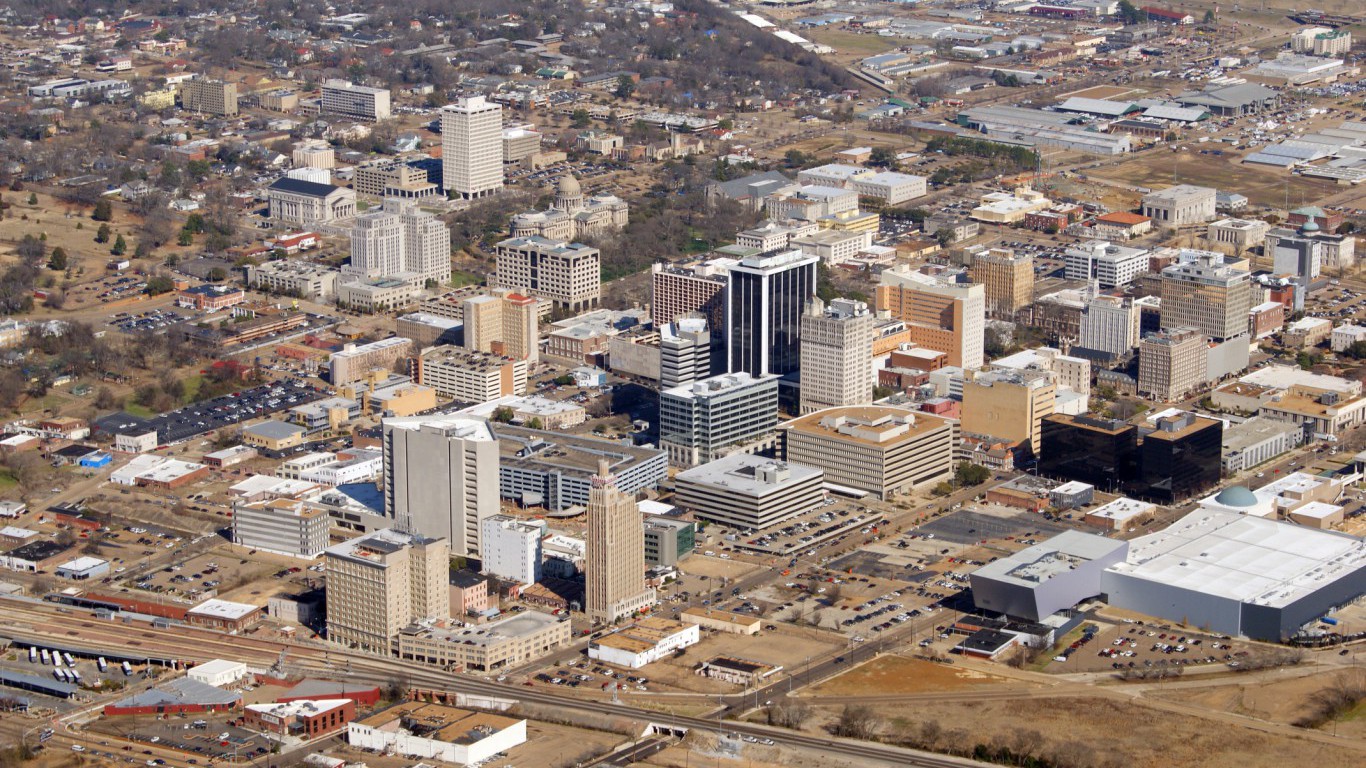
15. Jackson, Mississippi
> Population: 170,811
> Median home value: $92,600
> Poverty rate: 31.7%
> Pct. with at least a bachelor’s degree: 26.9%
Mississippi lags behind most of the country in many socioeconomic measures, and Jackson, the largest city in the state, is one of the worst places to live. Jackson has fewer bars, libraries, recreational centers, and movie theaters per capita than the U.S. as a whole, and is home to some of the cheapest real estate in the country. The median home value in Jackson is just $92,600, less than half the $194,500 national figure. Some 31.7% of the population lives in poverty, more than twice the 14.7% national rate.
Like much of Mississippi, Jackson’s economic growth has slowed substantially in recent years. Jackson lacks the high-tech STEM industries that have fueled growth in other mid-size metro areas, and the city’s 6.4% unemployment rate in 2015 was significantly higher than the 5.3% national rate. Jackson’s labor force grew by just 2.4% from 2013 to 2015, less than the 4.0% national job growth over the period.
[in-text-ad]
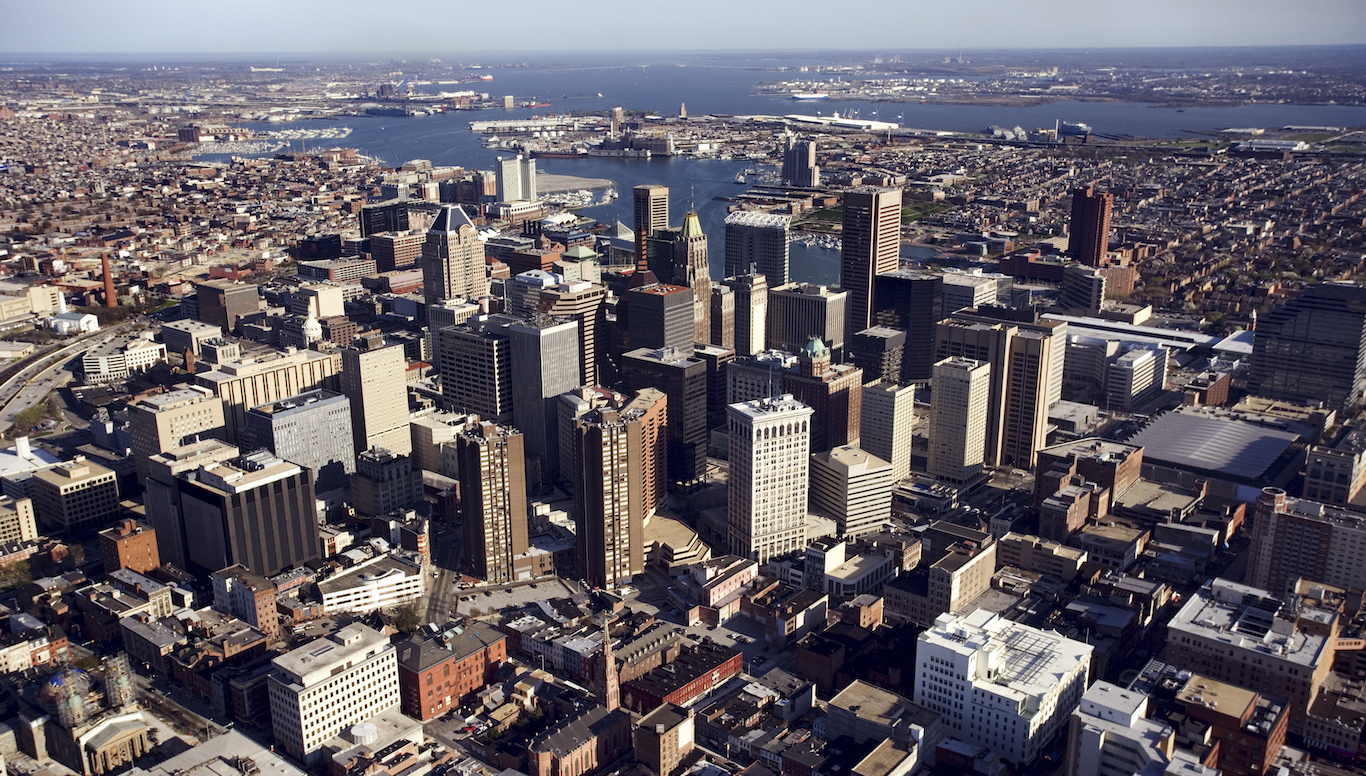
14. Baltimore, Maryland
> Population: 621,849
> Median home value: $155,600
> Poverty rate: 22.9%
> Pct. with at least a bachelor’s degree: 29.9%
Baltimore is one of the most dangerous cities in the United States. The city’s murder rate hit an all time high in 2015. That year, there were 1,536 violent crimes in the city for every 100,000 residents, the eighth highest violent crime rate of any U.S. city. The violence may have been partly fueled by the influx of drugs on the street following the looting of pharmacies during the unrest sparked by the police killing of Freddie Gray.
Others blamed the record year in crime in the city on economic and social disparities. Some 22.9% of Baltimore’s population lives below the poverty line, more than double the 9.7% poverty rate across Maryland.
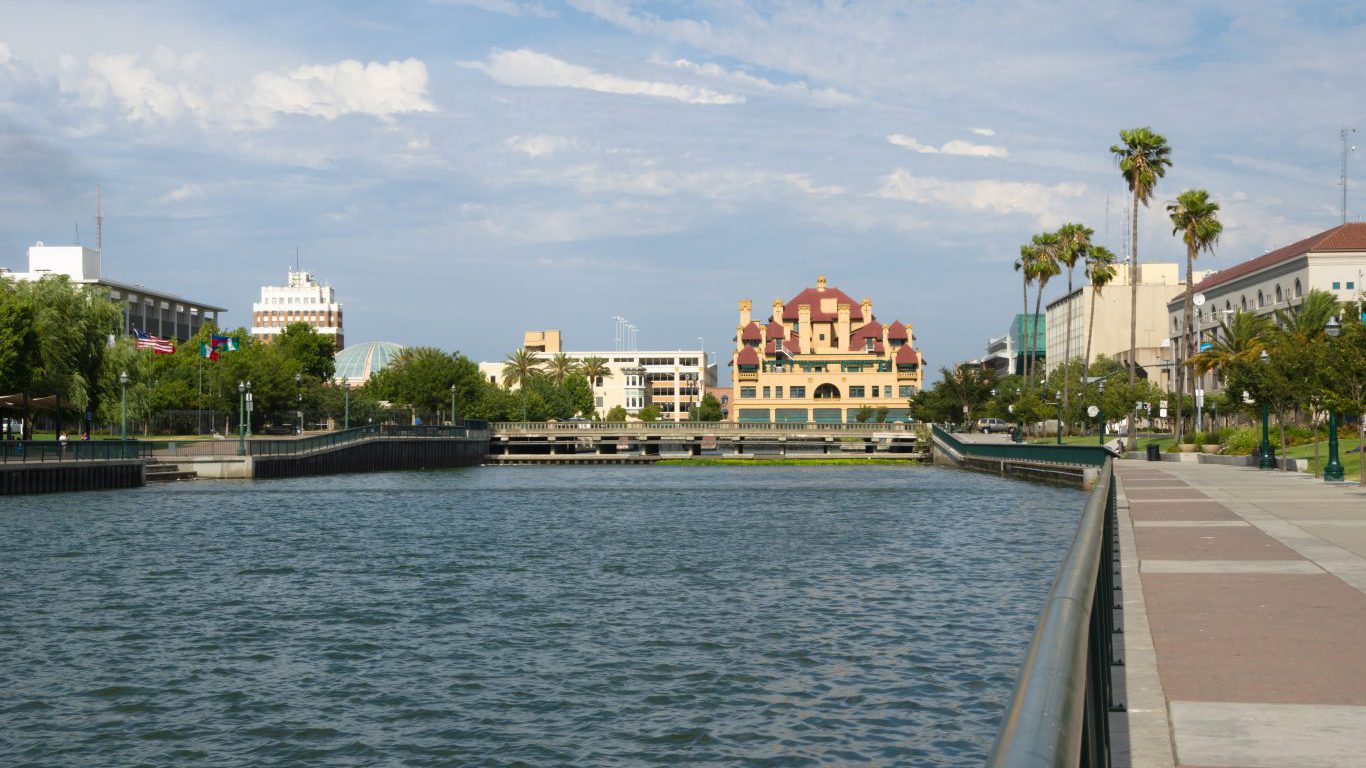
13. Stockton, California
> Population: 305,650
> Median home value: $224,300
> Poverty rate: 21.8%
> Pct. with at least a bachelor’s degree: 17.8%
There were 1,352 violent crimes per 100,000 Stockton residents in 2015, more than three times the national violent crime rate of 373 incidents per 100,000 Americans. In addition to a high crime rate, Stockton suffers from heavy air pollution. San Joaquin County has good air quality just 331 days out of the year on average, less than most U.S. counties.
Stockton was one of the cities hit hardest by the 2007 subprime mortgage crisis. The city’s financial situation became so dire that in 2012 Stockton became the largest city to ever file for bankruptcy — only to be outdone by Detroit the following year. While Stockton returned to solvency in 2015, the area’s economy remains in rough shape. The city’s unemployment rate of 9.6% in 2015 was far higher than the 5.3% national rate.
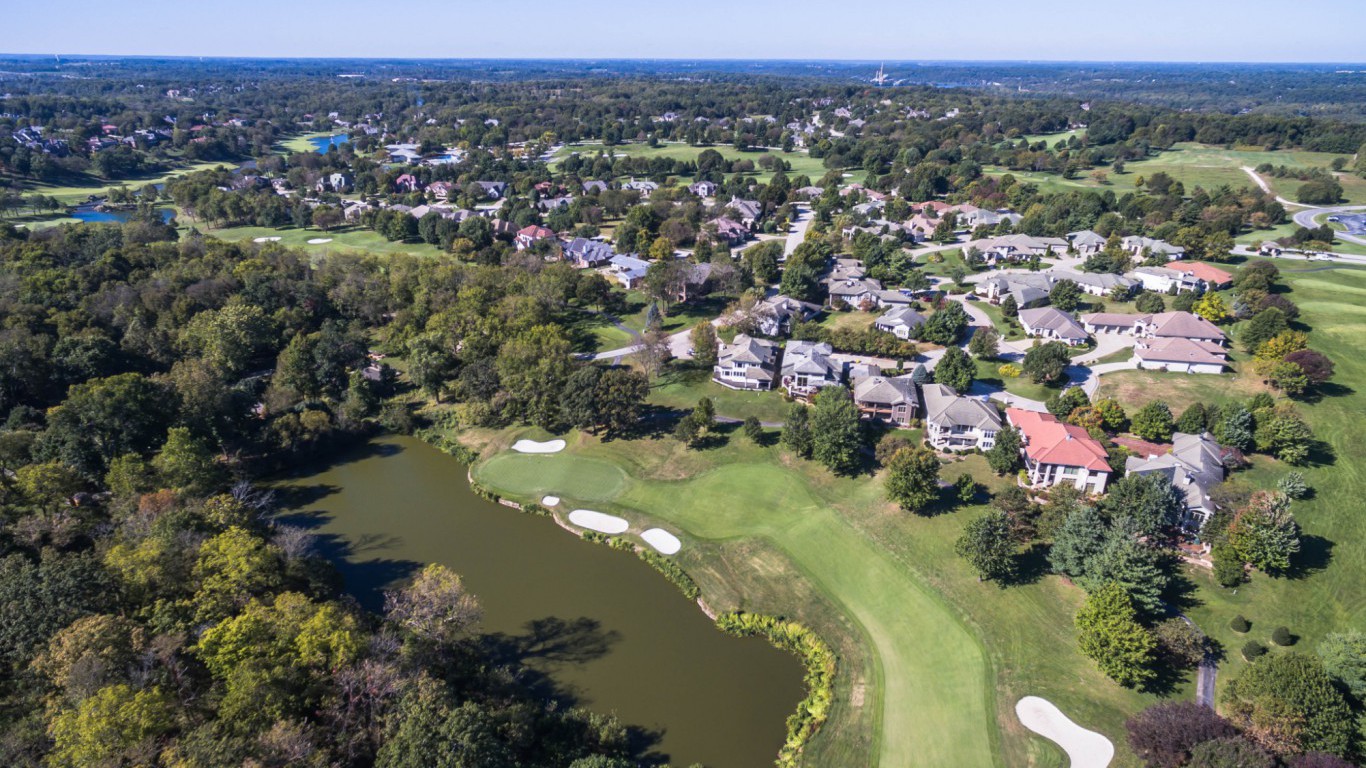
12. Springfield, Missouri
> Population: 166,798
> Median home value: $113,500
> Poverty rate: 24.1%
> Pct. with at least a bachelor’s degree: 28.0%
Few cities have a greater crime problem than Springfield, Missouri. The city’s annual violent crime rate of 1,356 incidents per 100,000 residents is more than three times the national violent crime rate of 373 per 100,000. Springfield’s property crime rate, at 7,795 incidents per 100,000 people, is also over three times the national property crime rate and the third highest of the 551 cities reviewed.
High crime in a city often coincides with high poverty in a somewhat circular cause and effect. Springfield’s poverty rate of 24.1% is nearly 10 percentage points greater than the national poverty rate.
[in-text-ad-2]

11. San Bernardino, California
> Population: 216,137
> Median home value: $201,300
> Poverty rate: 32.6%
> Pct. with at least a bachelor’s degree: 12.2%
Some 32.6% of San Bernardino residents live in poverty, the second highest poverty rate of any California city and more than double the 14.7% U.S. poverty rate. Serious financial hardship is partially the product of a stagnant job market. The city’s 8.2% unemployment rate is higher than in the vast majority of U.S. cities and well above the 5.3% nationwide jobless rate.
San Bernardino is not marred only by poor economic conditions, but also by poor environmental conditions. Air quality in San Bernardino County is hazardous for 57 days a year on average, more than nearly any U.S. county and more than twice the 22-day national average.
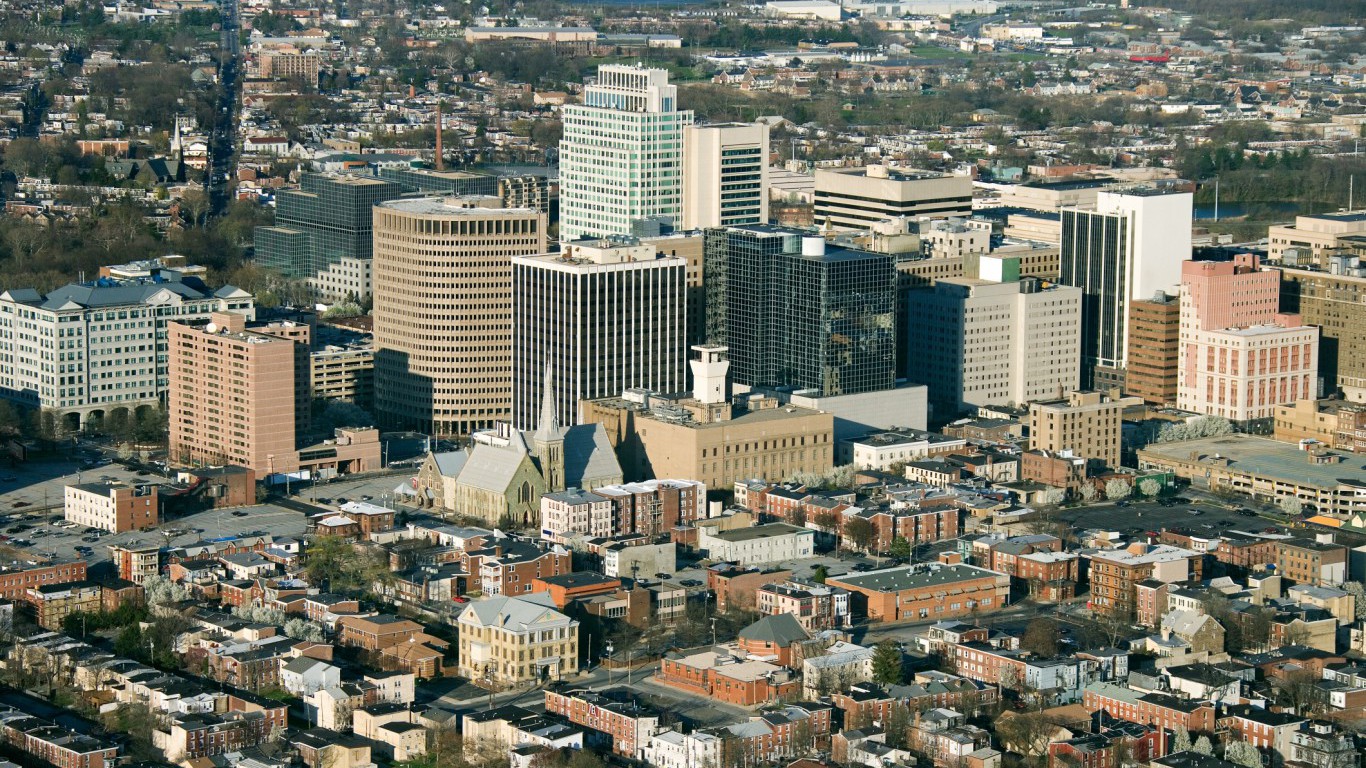
10. Wilmington, Delaware
> Population: 71,957
> Median home value: $160,300
> Poverty rate: 26.0%
> Pct. with at least a bachelor’s degree: 25.4%
The typical Wilmington household earns $41,035 a year, far less than the median income nationwide of $55,755. However, adjusted for the city’s high cost of living — groceries cost 10% more in Wilmington than they do nationwide, housing costs 26% more, and utilities cost 37% more — real area incomes are even lower.
Poor cities with tough job markets tend to have the most crime, and Wilmington, where 26.0% of the population lives in poverty and 6.9% of the labor force is unemployed, is no exception. There were 1,708 violent crimes reported per 100,000 Wilmington residents in 2015, the fifth highest violent crime rate of any U.S. city.
[in-text-ad]

9. Merced, California
> Population: 82,440
> Median home value: $204,400
> Poverty rate: 35.1%
> Pct. with at least a bachelor’s degree: 19.5%
Merced is located about 75 miles east of San Jose. While it does not face the same level of risk as those cities closer to the San Andreas fault, a serious earthquake is not out of the question for the California city. More tangible difficulties making the city a less than desirable place to live include an annual unemployment rate of 10.7%, worse than nearly any other city in the United States. In addition, Merced’s poverty rate of 35.1%, which is more than double the national rate of 14.7%, is the 10th worst among the 551 cities considered.
Relative to the size of its population, Merced is generally lacking in amenities, including below average numbers of restaurants, bars, libraries, and museums per capita.
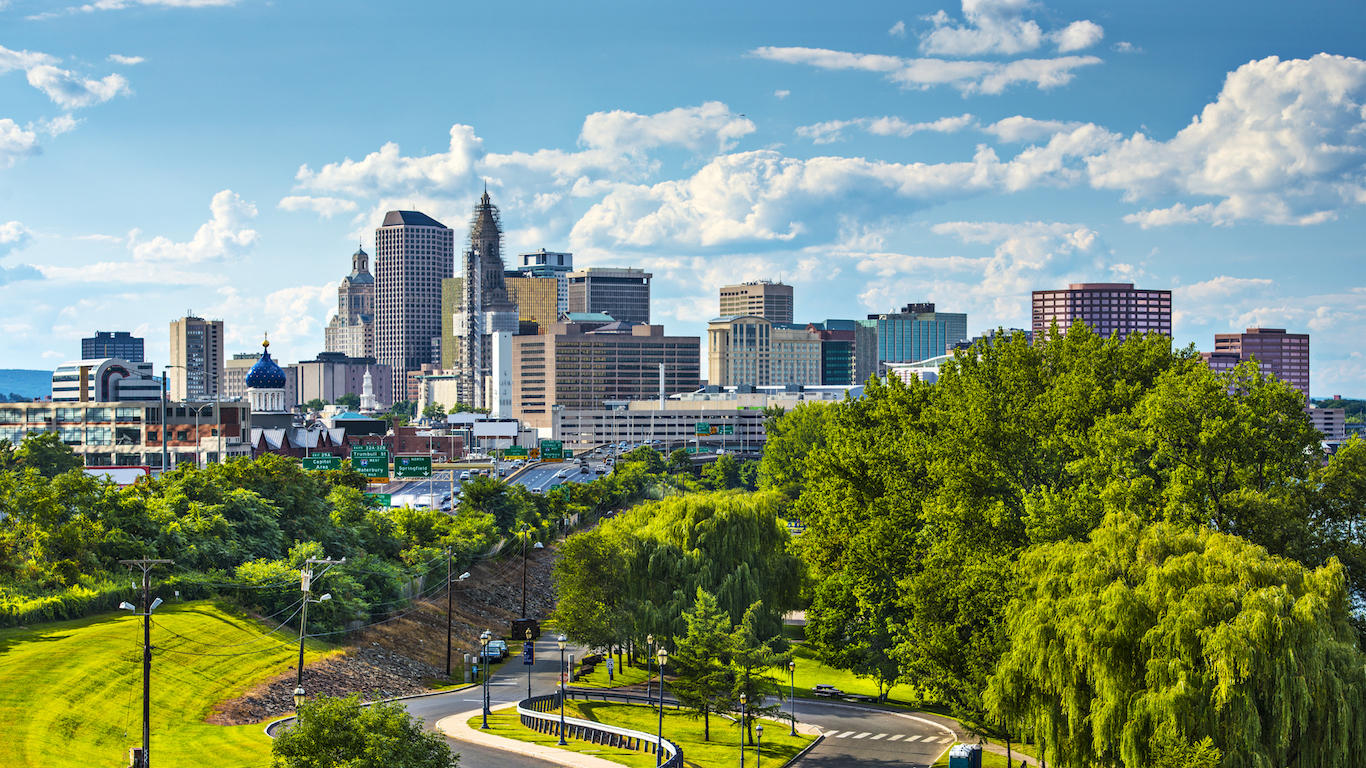
8. Hartford, Connecticut
> Population: 124,014
> Median home value: $159,200
> Poverty rate: 28.3%
> Pct. with at least a bachelor’s degree: 16.9%
Hartford is one of many cities in New England where the population is shrinking as more residents move south in favor of a low cost of living and good job market. With goods and services costing 17 cents more on the dollar in Hartford than they do nationwide, the city is one of the most expensive in the country. Hartford is also tied with Flint, Michigan and Compton, California as the city with the seventh highest unemployment rate. An estimated 10.4% of the Hartford labor force was unemployed in 2015, nearly double the 5.3% national figure. While the U.S. population grew 3.9% in the last five years, Hartford’s population declined by 0.7%.
Hartford’s economic decline has led to widespread crime and poverty. Some 28.3% of Hartford residents live below the poverty line, far more than the 14.7% national poverty rate. There were 1,141 violent crimes per 100,000 residents in Hartford in 2015, one of the worst violent crime rates of any city.

7. Albany, Georgia
> Population: 71,109
> Median home value: $92,600
> Poverty rate: 32.0%
> Pct. with at least a bachelor’s degree: 19.0%
Population trends are often indicative of the desirability of a city. New residents are often attracted by a healthy economy and job market, while residents flee areas with a poor economy, a high crime rate, and widespread poverty. As the national population expanded by 11.5% over the last decade, the population of Albany, Georgia declined by 4.0%.
This decline appears to reflect some of the problems the southern Georgia city faces. Albany’s job market, for example, does not compare favorably to most U.S. cities. The city’s annual unemployment rate is 7.9%, compared to the 5.3% national unemployment rate. Similarly, while the U.S. workforce grew by 4.0% between 2013 and 2015, total employment in Albany declined by 1.7% over the same period, the second largest employment decline out of the 551 cities reviewed. Almost one-third of the city’s population lives in poverty, well more than double the national poverty rate.
[in-text-ad-2]
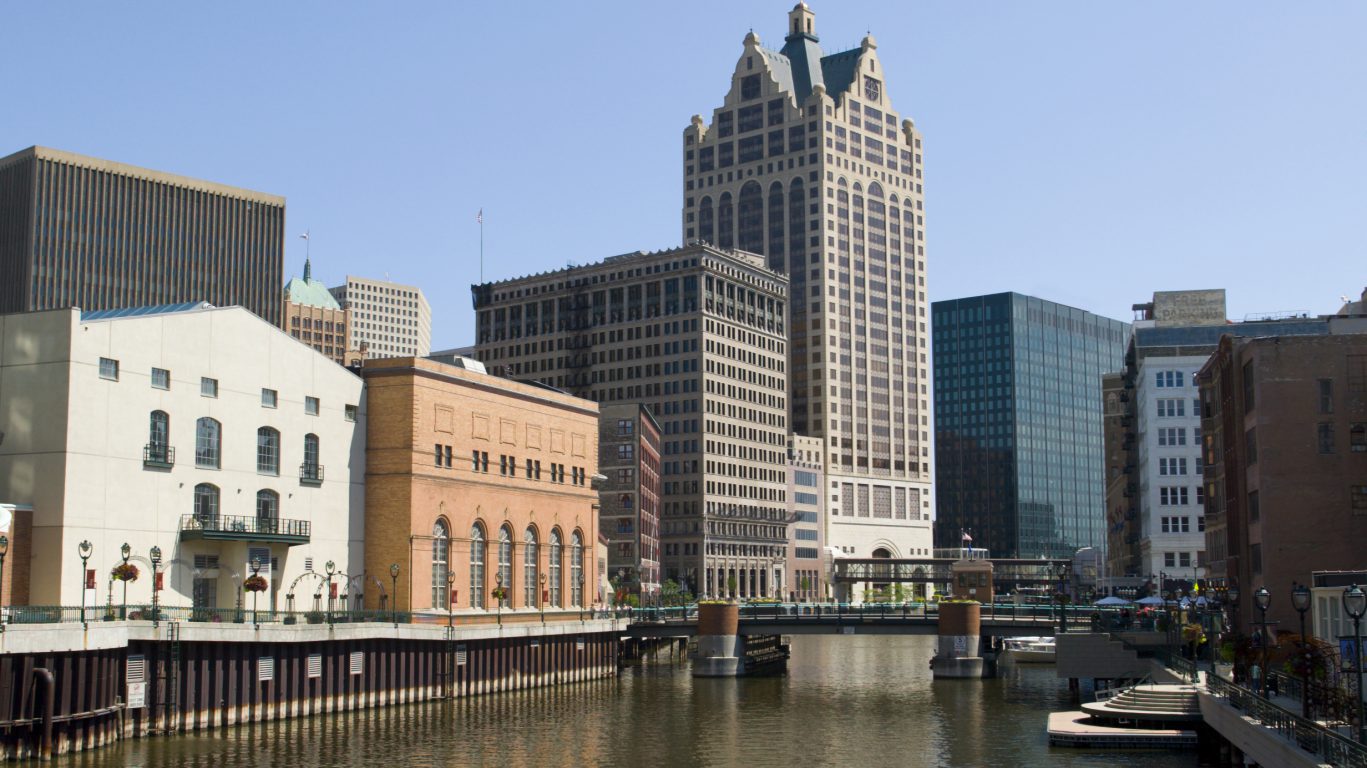
6. Milwaukee, Wisconsin
> Population: 600,154
> Median home value: $114,000
> Poverty rate: 26.8%
> Pct. with at least a bachelor’s degree: 23.9%
Some 26.8% of Milwaukee residents live in poverty, the highest poverty rate of any city in the state and well above the 14.7% U.S. poverty rate. The city also has the lowest median household income, at $37,495 a year, and second lowest unemployment rate, at 6.7%, in the state.
Economically stressed areas often struggle with higher rates of violent crime, and Milwaukee is no exception. There were 1,596 violent crimes for every 100,000 city residents in 2015, more than triple the violent crime rate in the next most dangerous Wisconsin city and the sixth highest violent crime rate of U.S. cities. Due in part to the city’s high crime rate, Milwaukee was one of a handful of U.S. cities selected in 2016 to receive federal assistance to reduce violence.
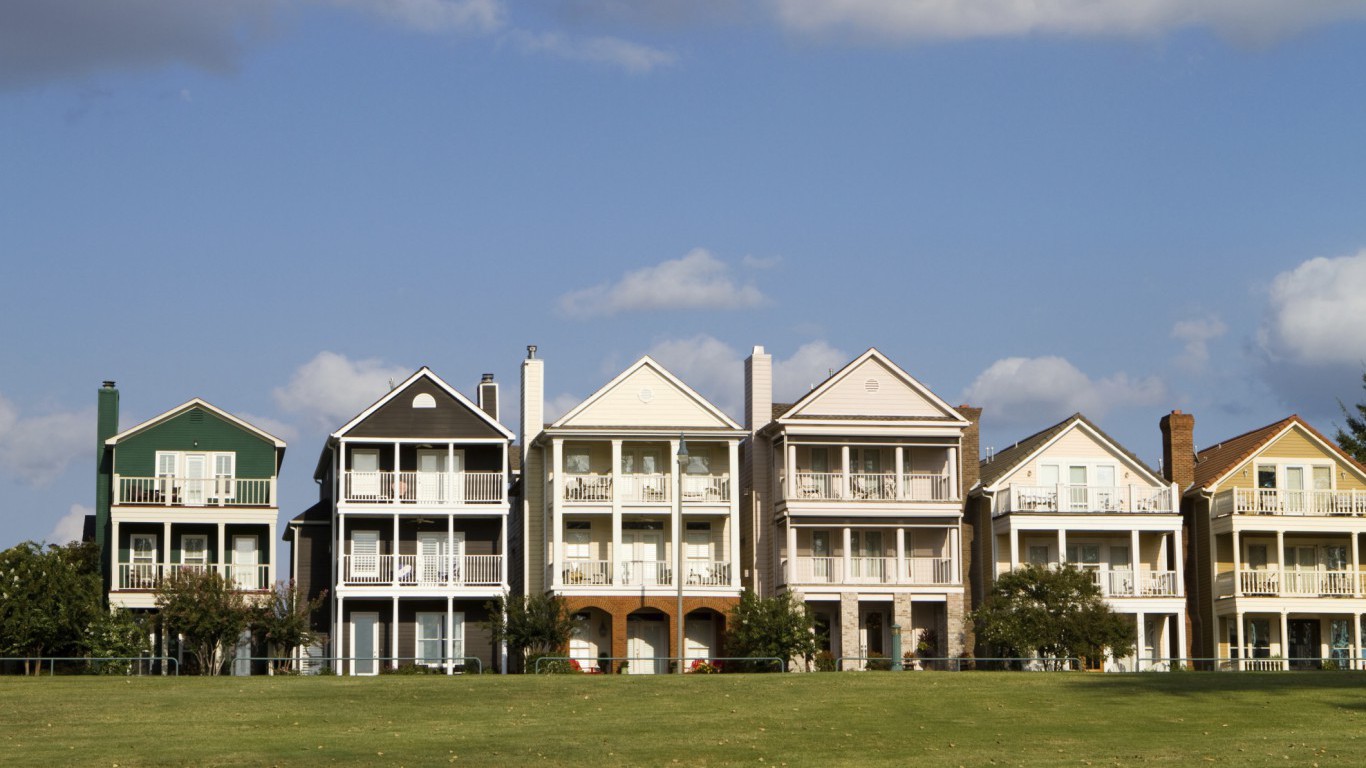
5. Memphis, Tennessee
> Population: 655,760
> Median home value: $94,400
> Poverty rate: 26.2%
> Pct. with at least a bachelor’s degree: 24.9%
One of the largest cities to make this list, Memphis struggles with several issues that make it a less than desirable place to live. Chief among these is one of the worst crime rates of any major city. The city’s annual violent crime rate of 1,740 incidents for 100,000 residents, which is close to five times the national rate, is fourth highest of the 551 cities considered. The city’s property crime rate of 5,631 for every 100,000 residents is more than double the national rate.
Memphis’ housing is relatively inexpensive, but like many cities on this list, that likely largely reflects the ability of Memphis’ citizens to pay. Over one-quarter of the population lives in poverty, and the typical household’s income is less than $37,000, compared to the national median household income of $55,775.
[in-text-ad]

4. St. Louis, Missouri
> Population: 315,685
> Median home value: $130,800
> Poverty rate: 24.9%
> Pct. with at least a bachelor’s degree: 34.7%
St. Louis is representative of the economic decline that afflicted many large industrial cities over the latter part of the 20th century. Decades of manufacturing decline, white flight, and exclusionary zoning in St. Louis have led to some of the worst urban decay, racial segregation, and income inequality of any major city today. Some 24.9% of St. Louis residents live in poverty, far more than the 14.7% national figure. St. Louis has struggled with a high crime rate since the 1960s and today has the highest violent crime rate of any U.S. city. There were 1,817 violent crimes reported per 100,000 St. Louis residents in 2015, nearly five times the national rate.
Many of the economic problems in St. Louis are tied to the city’s rapid population decline. The city’s population is less than half of what it was during its 1950 peak of 860,000 people, and it continues to decline today. While the U.S. population grew 11.5% over the last 10 years, the number of residents in St. Louis fell 5.4%.
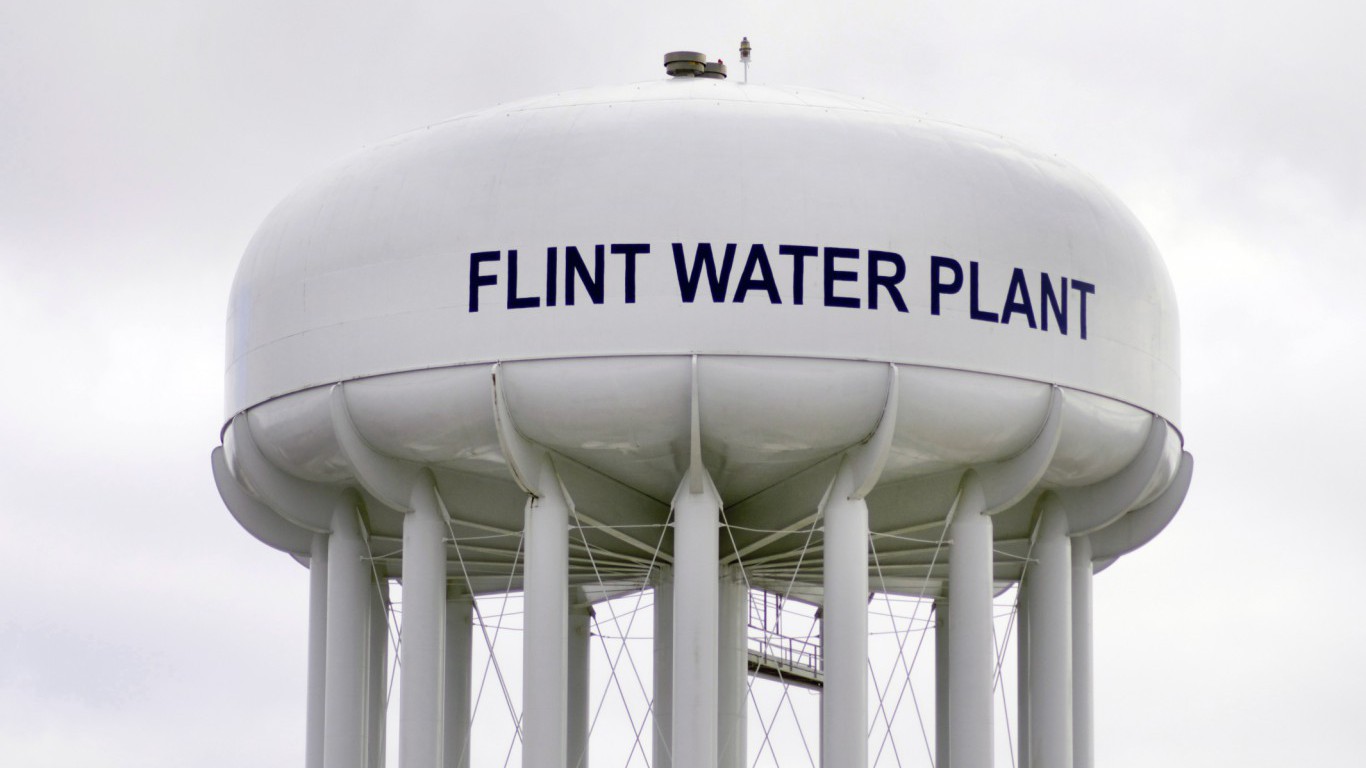
3. Flint, Michigan
> Population: 98,297
> Median home value: $25,900
> Poverty rate: 40.8%
> Pct. with at least a bachelor’s degree: 11.8%
Like many other rust belt cities, Flint’s downward spiral is closely tied to the decline of the American manufacturing industry. General Motors once provided some 30,000 at its Flint-based Buick manufacturing plant, all of which are now gone. Recently, the city was at the center of national attention when, in 2015, the Environmental Protection Agency announced the presence of dangerously high levels of lead in Flint’s public water.
A lack of reliable municipal services and the gutting of the city’s economic backbone has had major consequences. The typical Flint household earns only $25,342 a year, less than half the nationwide median income and the second lowest in the Great Lakes region. Additionally, the city’s 40.8% poverty rate is the highest in the nation. In the last 10 years, Flint’s population has declined by 12.2%, one of the steepest declines of any U.S. city.
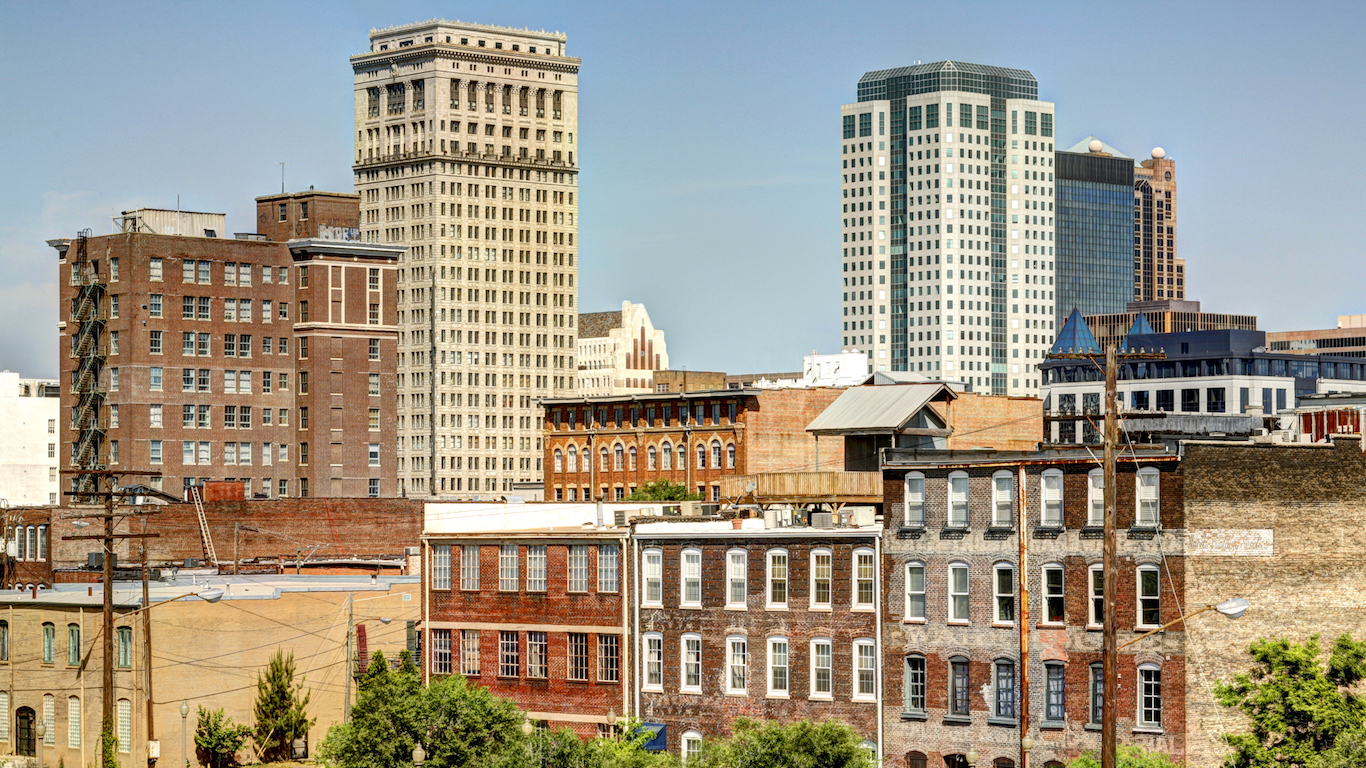
2. Birmingham, Alabama
> Population: 214,911
> Median home value: $93,000
> Poverty rate: 29.2%
> Pct. with at least a bachelor’s degree: 25.3%
Declining population and declining jobs in a city is indicative of a struggling economy, particularly when the vast majority of major cities are growing. Of the 551 large cities reviewed, the population fell in only 42 over the past decade, and annual employment declined in less than 30 over the last two years. Birmingham is one of the exceptions in both cases, with a 3.3% 10-year population loss and a 0.9% employment decline between 2013 and 2015.
Birmingham is one of the poorest cities in the United States. About 29.2% of the city’s population lives in poverty, roughly double the 14.7% U.S. poverty rate, and the typical household earns just $32,378 a year, over $23,000 below the national median household income.
[in-text-ad-2]

1. Detroit, Michigan
> Population: 677,124
> Median home value: $42,600
> Poverty rate: 39.8%
> Pct. with at least a bachelor’s degree: 14.2%
Once the fourth largest city by population and wealthiest by income per capita, Detroit’s economic decline over the past several decades may be the largest of any U.S. city. Detroit’s population is approximately one-third of what it was at its 1950 peak of 1.8 million people, and it continues to decline at a near nation-leading pace. The number people living in Detroit fell 19% over the past 10 years to just 677,124 today, the second largest population decline of any large city over that period. The typical Detroit household earns just $25,980 a year, less than half the $55,755 national median household income.
There were 1,760 violent crimes reported per 100,000 Detroit residents in 2015, the second highest violent crime rate of any U.S. city. Crime and overall urban decay have depressed real estate prices in the city to a fraction of their former value. The typical occupied home in Detroit is worth just $42,600, the lowest median home value of any city other than nearby Flint, Michigan.
Detailed Findings
Low-income families tend to live in communities with less stable housing, worse health systems, greater exposure to stressors such as violent crime, less secure employment, and higher exposure to poor air quality and environmental toxins. Struggling with many such factors, residents often find it hard to escape the cycle of poverty.
Poverty has wide-reaching effects, not just on those living in poverty but on entire communities and neighborhoods. It can coincide with higher violent crime and generally worse economic development, factors which these cities tend to have in common.
In the worst cities to live in, incomes tend to be lower and poverty rates higher. Of the 50 worst cities, none have incomes higher than the nationwide median households income of $53,657 a year. In 31 of the 50 cities, more than 25% of the population lives in poverty, compared with the national poverty rate of 15.5%.
How far a paycheck can go in a given city is just as important as the size of the paycheck — and some cities are far more expensive than others. Housing expenses usually dominate household budgets. Nationwide, the typical home costs 3.5 times the annual median household income. Housing is less affordable in half of the worst cities to live in. In Miami Beach, the typical home costs nine times the city’s annual median household income.
However, in the cities where housing is relatively affordable, the advantage is overshadowed by abysmal home values and struggling housing markets. This is most notably the case in cities such as Flint, Detroit, and Lansing, Michigan, as well as Youngstown and Canton, Ohio. While for some people in these areas a home can be bought outright on less than a year’s salary, the affordability is a sign of extremely poor economic health.
Violence is closely associated with a range of negative social and economic outcomes for all involved, unstable employment, lower cognitive functioning among children, and anxiety. The violent crime rates in almost all of the worst cities to live in is higher than the national rate of 373 reported incidents per 100,000 people. In about half of the 50 worst cities, the violent crime rate exceeds 1,000 incidents per 100,000 people.
Correction: Due to an editing error, Birmingham was incorrectly identified as the capital of Alabama. The capital of Alabama is Montgomery. The error has been corrected.
Methodology
To determine America’s 50 worst cities to live in, 24/7 Wall St. considered the roughly 550 cities that the U.S. Census Bureau reported as having populations of more than 65,000 residents in 2015. Only the top performing city in each county was considered in our ranking. Data were collected in nine major categories: crime, demography, economy, education, environment, health, housing, infrastructure, and leisure.
Within each category, specific measures contributed to a city’s overall category score. For example, the economy category included median household income adjusted for cost of living, the ratio between a city’s and its state’s median household income, poverty and unemployment rates, as well as a city’s three-year employment growth. Each measure was adjusted to range from 0 to 1 using min-max normalization, with lower scores indicating better outcomes.
Normalizing each measure, as opposed to aggregating category scores in other ways, allowed us to assign weight to individual measures for added importance rather than entire categories. It also enabled us to expose the principal components of our index — those measures with wider variation that disproportionately determine the rank of a city’s composite score. The housing category, for example, had the widest range, giving it the greatest pull in our index. Crime and economy also had large variances.
We did not include any measures in the demography category in our composite index. However, this category provided exclusion rules. Cities that are better to live in often attract job seekers and their families. Conversely, labor market slack, unaffordable housing, high crime rates, or a myriad of other negative factors may induce people to move to a different city with better prospects. Thus, we excluded cities with negative five- or 10-year population growth rates. Population figures are from the Census Bureau’s 2015 American Community Survey (ACS).
The crime category consists of both violent and property crime rates from the Federal Bureau of Investigation’s 2015 Uniform Crime Report. High crime rates have the potential to make a city less desireable. As a result, cities with crime rates lower than the national rates were rewarded, while cities with higher crime rates were penalized.
A strong economy and labor market are, for some, the only considerations when determining where to live. The economy category includes a city’s 2015 unemployment rate and employment growth from 2013-2015, both from the Bureau of Labor Statistics. Additionally, we considered the poverty rate, which, if too high, may deter prospective residents from moving to the city. Cities were penalized for having poverty rates above the national rate of 14.7%. Our goal was to identify cities that were liveable for everyone, not just the rich. Still, if incomes are too low, a city may not be desireable. To that end, we adjusted median household income for cost of living in the city. Cities were penalized if cost-adjusted incomes were less than $44,000 or more than $112,000 a year, roughly 80% to 200% of a typical household’s income nationwide. Poverty rates and median income came from the 2015 ACS. Cost of living data came from property and real estate data provider ATTOM Data Solutions.
A strong school system may be another consideration for parents looking to move. As a proxy for school system strength, we considered high school standardized test scores relative to state scores from ATTOM Data Solutions. Test score data are for 2015 or the most recently available year. Additionally, the education category included the percentage of adults with at least a bachelor’s degree from the ACS, as well as the number of colleges and universities in a city per 100,000 residents from the Department of Education. Both measures are as of 2015.
For people who like being outdoors — either for work or pleasure — a city’s air quality and weather may be of chief importance. Whereas other measures in this index are specific to an individual city, many metrics in this category describe the county in which the city is located because weather is likely similar, if not the same, in these two geographies. In this category, we included an air quality index to assess the levels of a variety of pollutants on a given day. Additionally, we considered an index measuring natural hazard risk, as well as average monthly rainfall. All data in this category came from ATTOM Data Solutions.
Access to quality hospitals may be another reason Americans live in the places they do. From the Centers for Medicare and Medicaid Services (CMS), we calculated 30-day risk-adjusted mortality rates of heart attacks, COPD, heart failure, pneumonia, and stroke. Also from CMS, we examined the rate at which individuals were readmitted to a hospital within 30 days of being discharged. This category also includes preventable hospitalizations — the share of hospitalizations that could have been treated with outpatient or ambulatory care for every 1,000 Medicare recipients from County Health Rankings.
For many American homeowners, homes constitute the vast majority of wealth. An investment of this magnitude requires careful consideration and may be the chief reason that people decide to live where they do. In our housing index, we considered the ratio of a city’s median home value to the statewide median home value. Cities were penalized if a city’s home values were worth less than 90% of statewide home values. Conversely, if home values were typically 25% higher than across the state, high barriers to entry exist that can make a city unaffordable. As an additional measure of affordability, we included the ratio of median home value to median annual household income. This ratio — called a price-to-income ratio — helps identify cities that are liveable for a broad audience. We also considered median property taxes as a percentage of median home value. All data in this category came from the 2015 ACS.
Proximity to work may be another factor in determining where to live. According to the Texas A&M Transportation Institute, Americans waste nearly 7 billion hours — or $160 billion — due to commuter traffic congestion. From the ACS, we considered the percentage of commuters travelling to work by foot or public transportation. Additionally, we reviewed the average time it takes to travel to work each day. Lastly, we included the number of airports in the metro area in which the city is located. There are, for example, no airports in New York County, the primary county of New York City. However, at least three major airports exist outside county limits — and within the metro area — that service people who live in the city. Airport data came from the Federal Aviation Administration and only consider operational public-use and commercial airports as of 2015.
The leisure category can be broken into two parts: activities that take place in the city and outside it. Within a city, residents may take advantage of restaurants and bars, libraries and archives, theater companies, fitness and recreational sports centers, museums, movie theaters, hotels, or amateur and professional sports teams. To engage in other pastimes — skiing, for example — residents likely have to leave city limits. Thus, we included in this index the number of zoos, nature parks, ski resorts, and golf courses in the counties surrounding the city. All data in this category were aggregated to the city level from 2014 Zip Code Business Patterns, a program maintained by the Census and adjusted for the city’s 2015 population.
Credit card companies are pulling out all the stops, with the issuers are offering insane travel rewards and perks.
We’re talking huge sign-up bonuses, points on every purchase, and benefits like lounge access, travel credits, and free hotel nights. For travelers, these rewards can add up to thousands of dollars in flights, upgrades, and luxury experiences every year.
It’s like getting paid to travel — and it’s available to qualified borrowers who know where to look.
We’ve rounded up some of the best travel credit cards on the market. Click here to see the list. Don’t miss these offers — they won’t be this good forever.
Thank you for reading! Have some feedback for us?
Contact the 24/7 Wall St. editorial team.